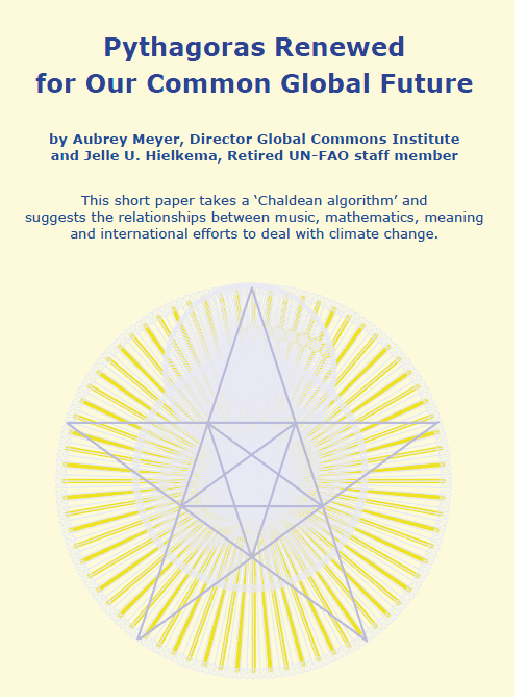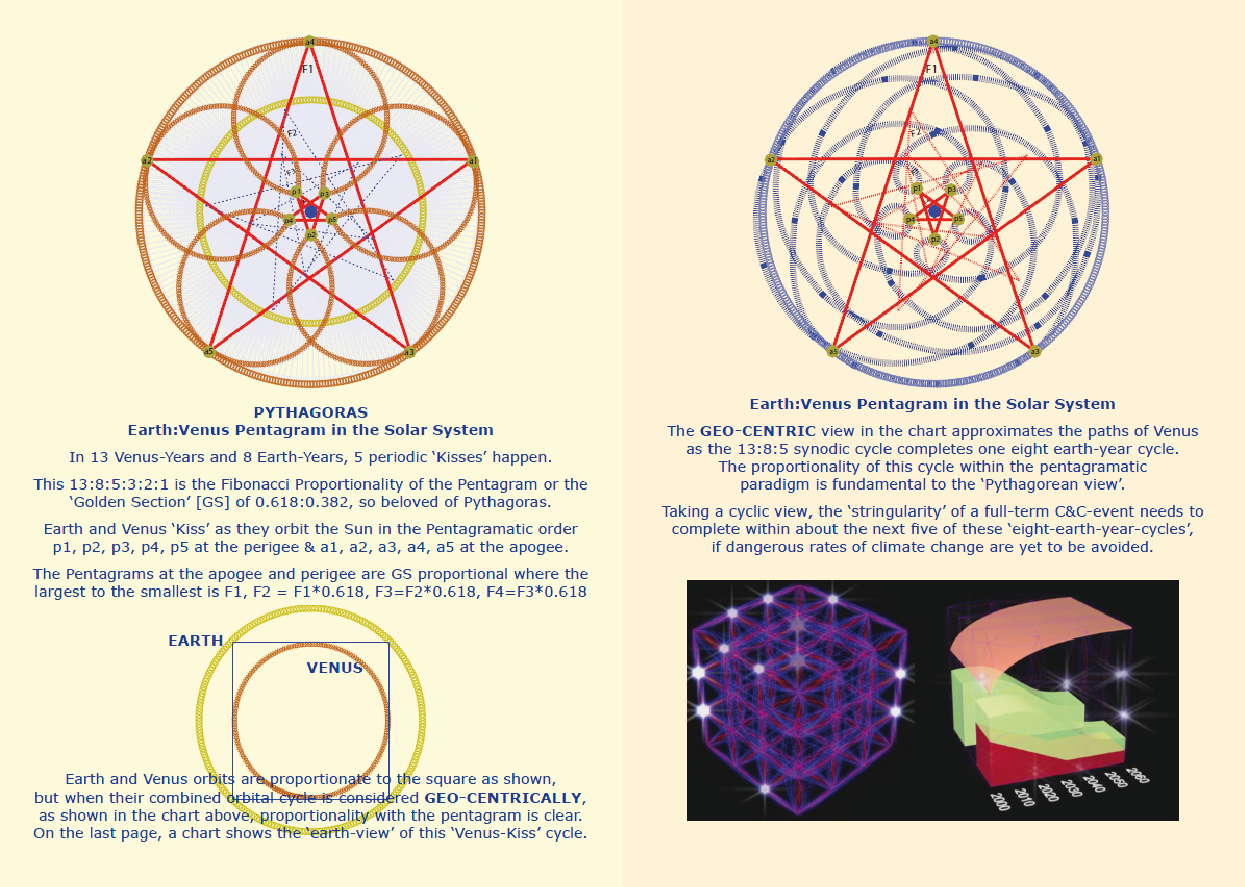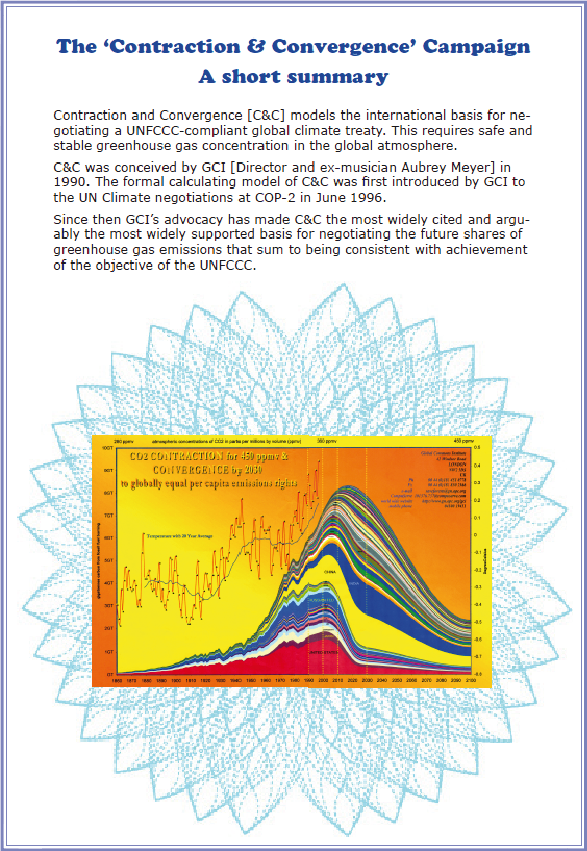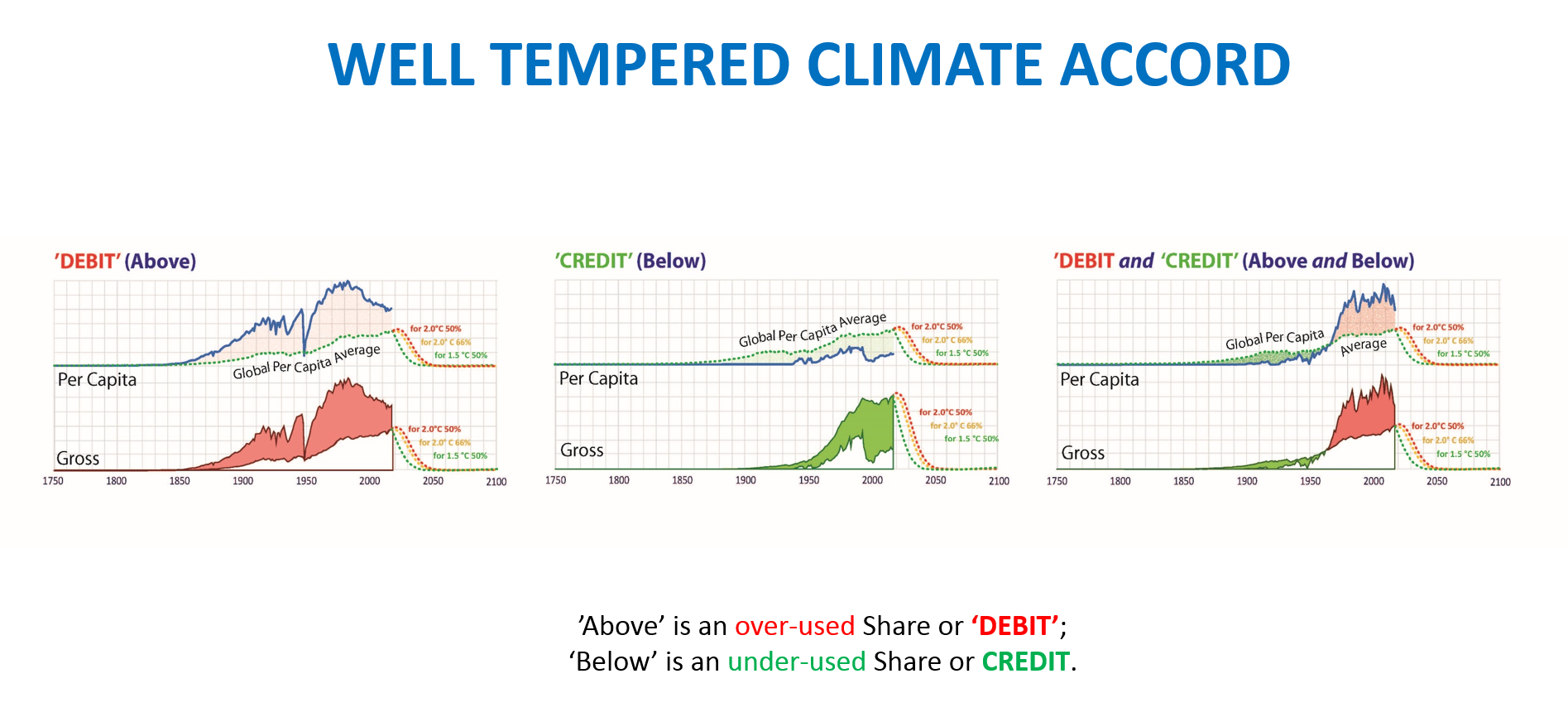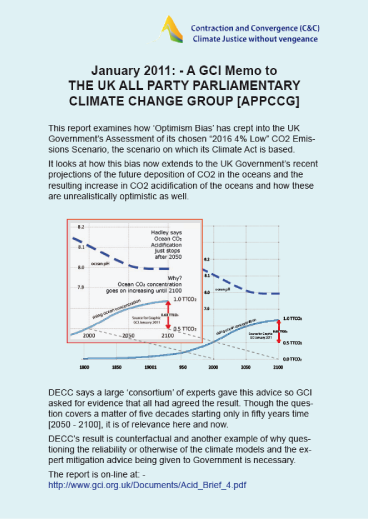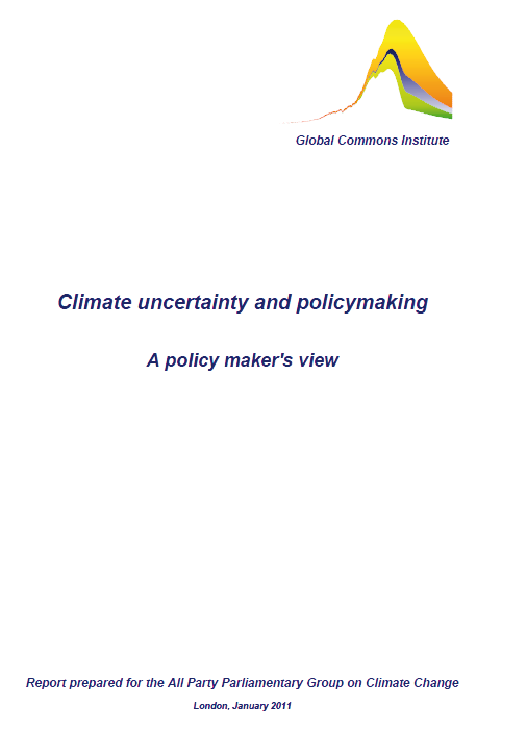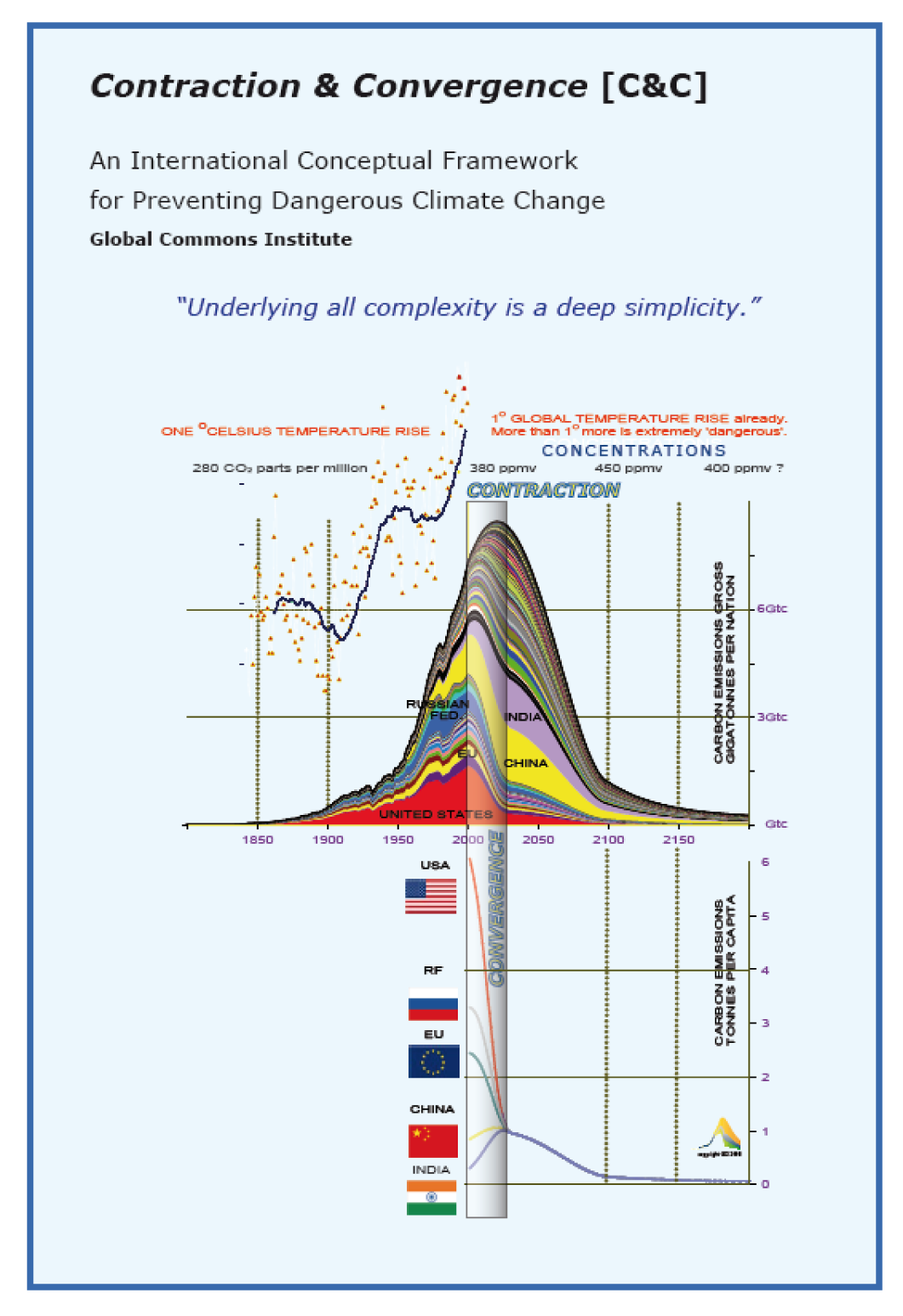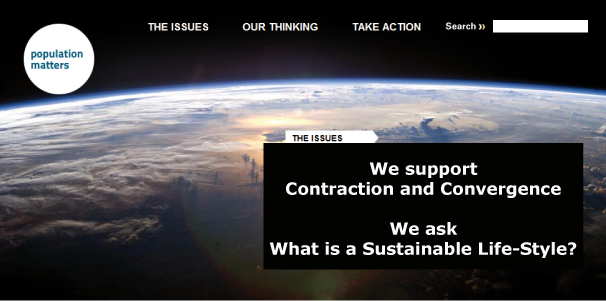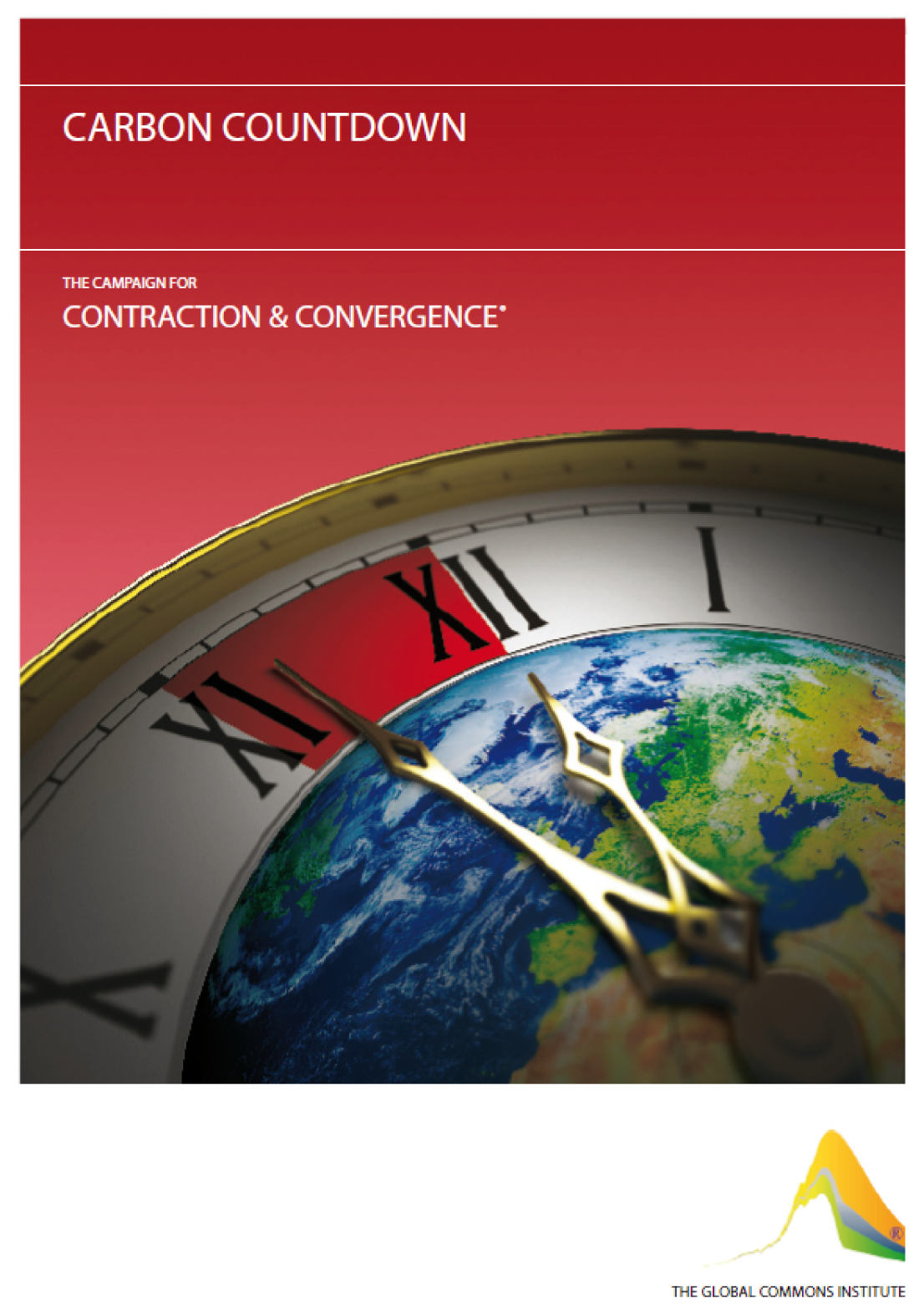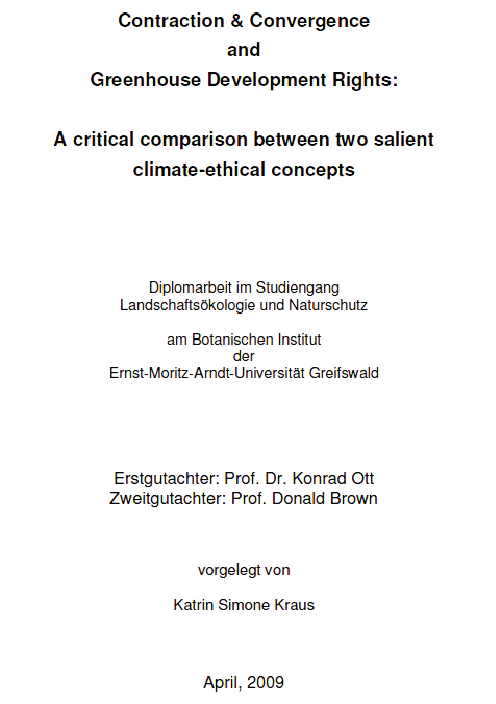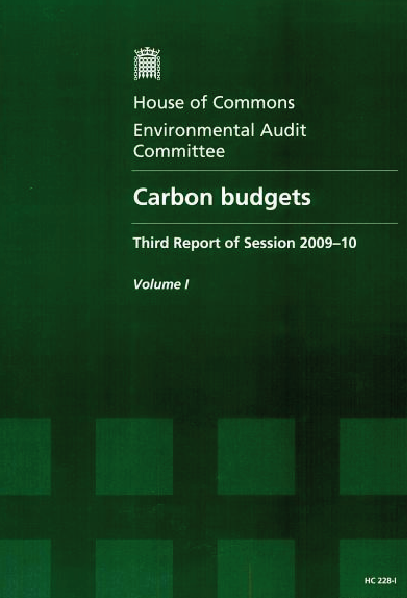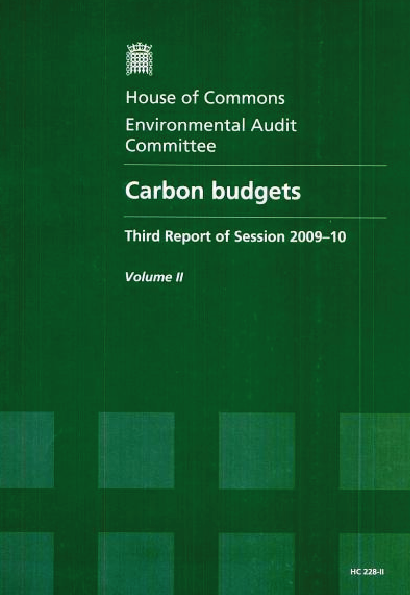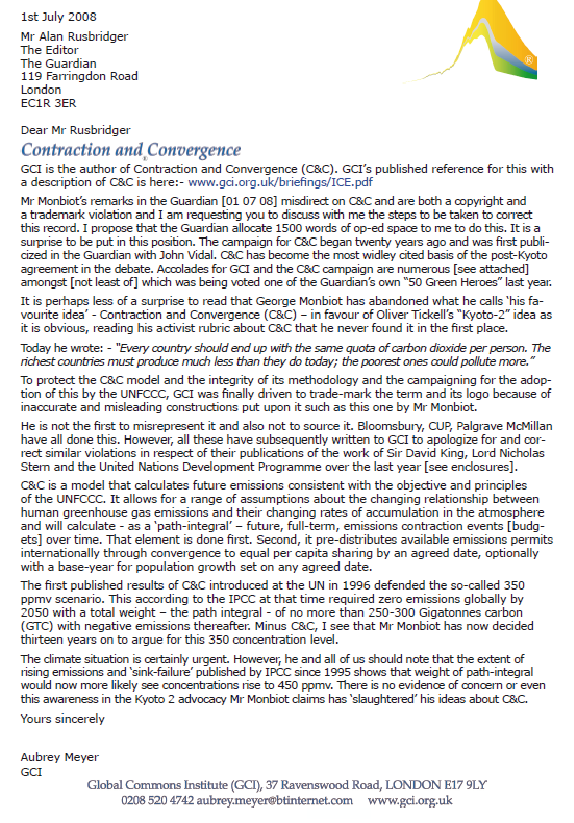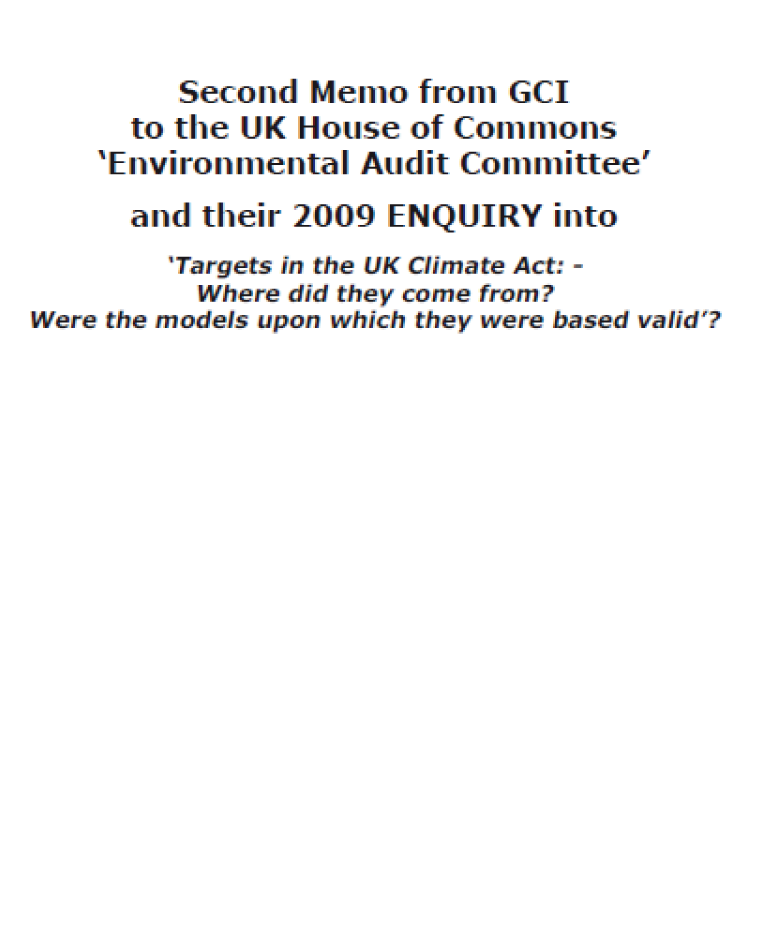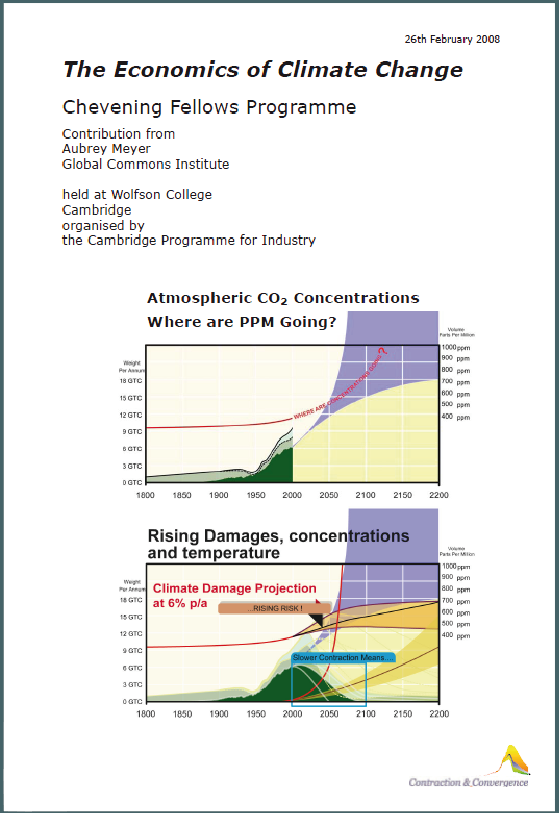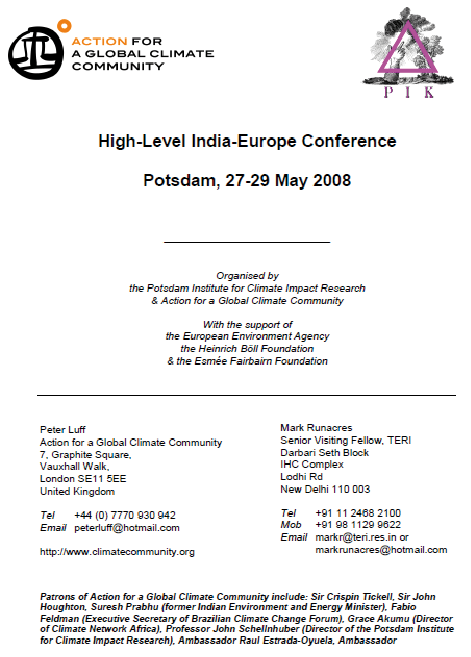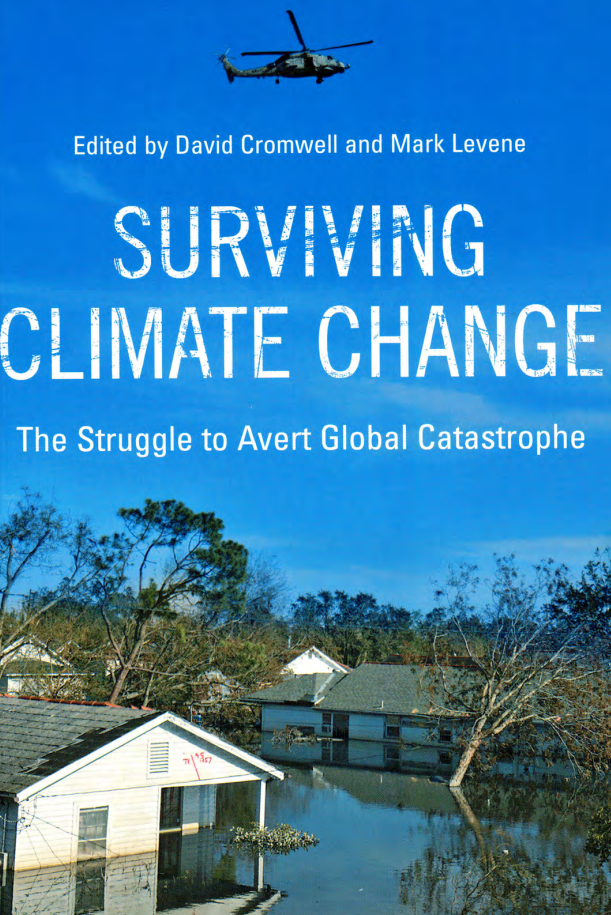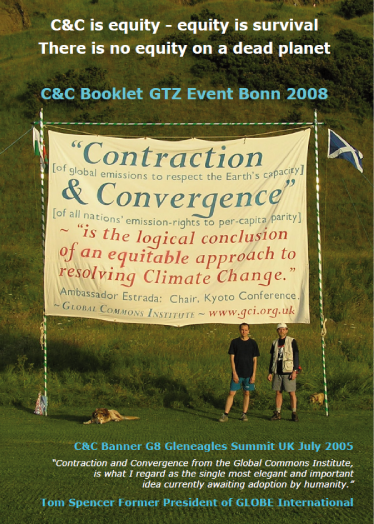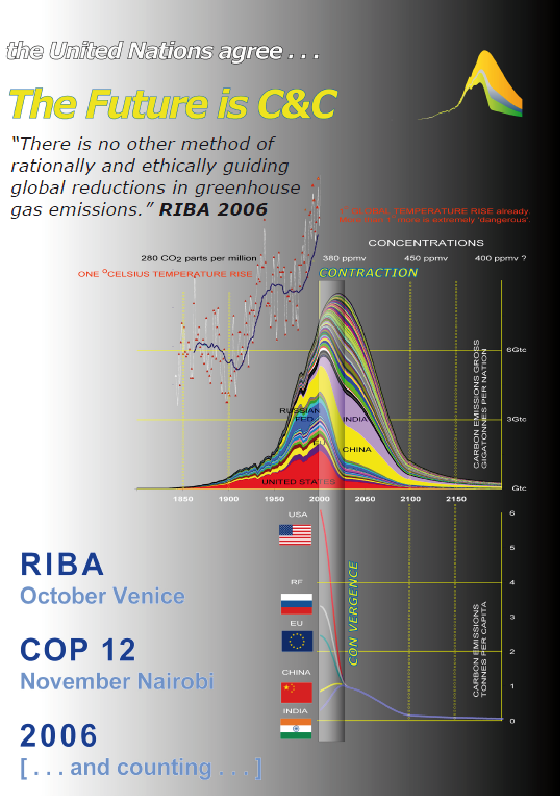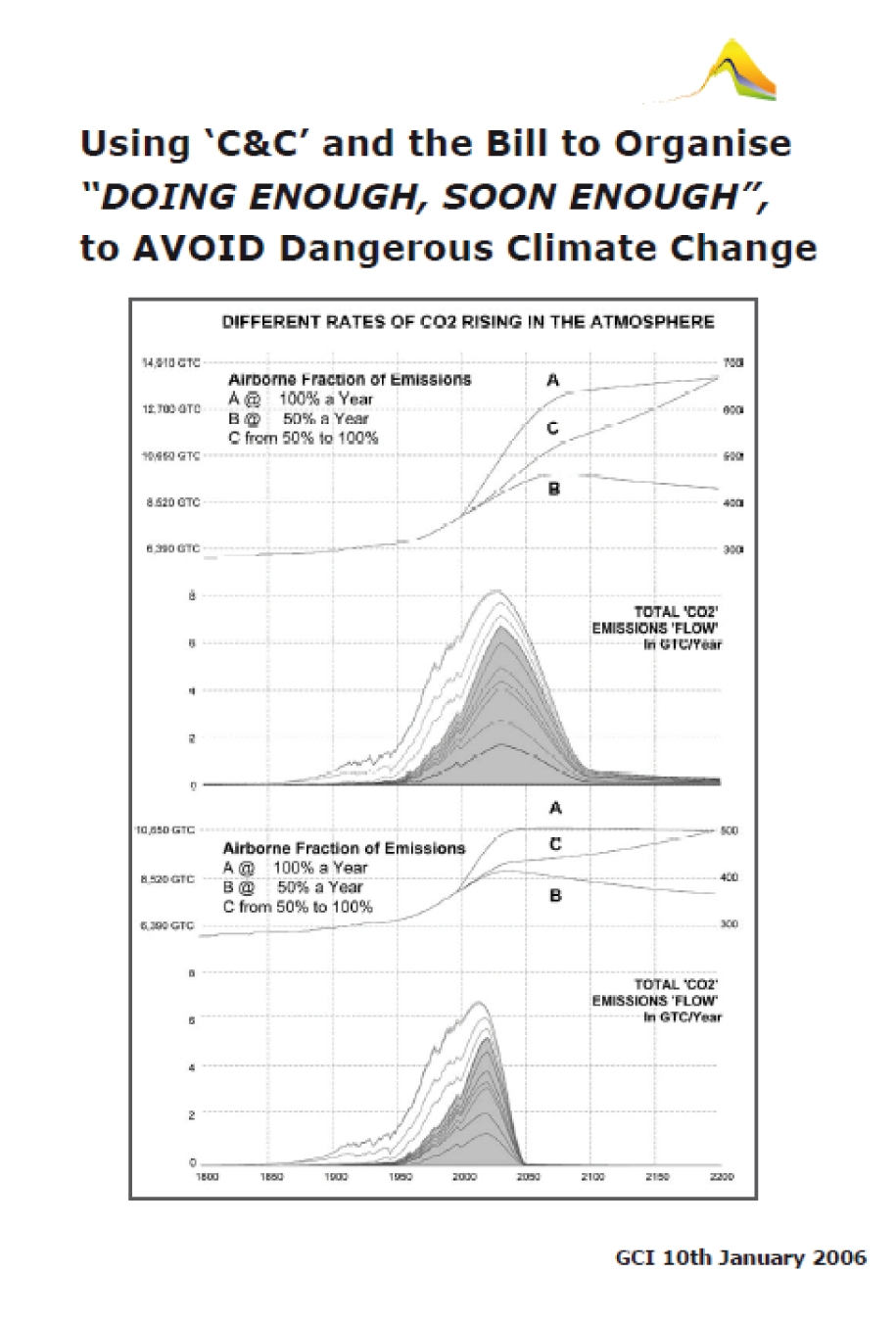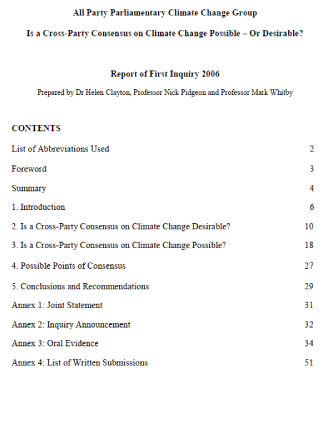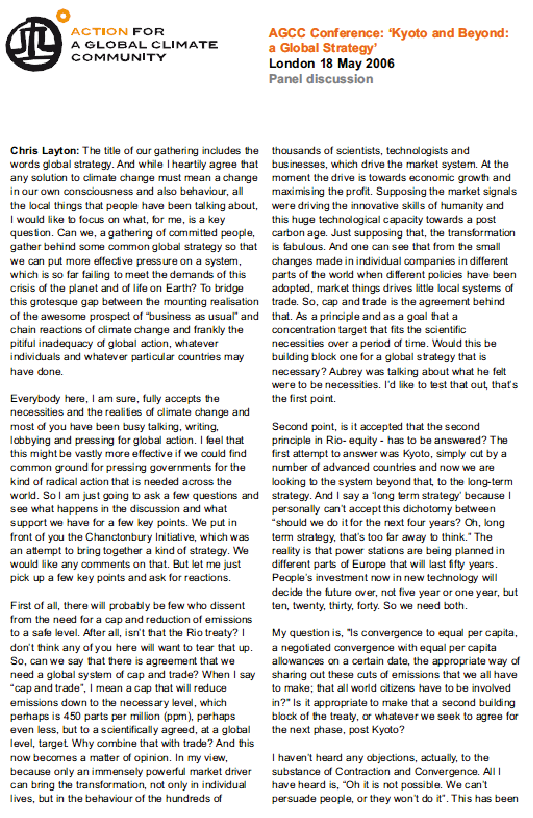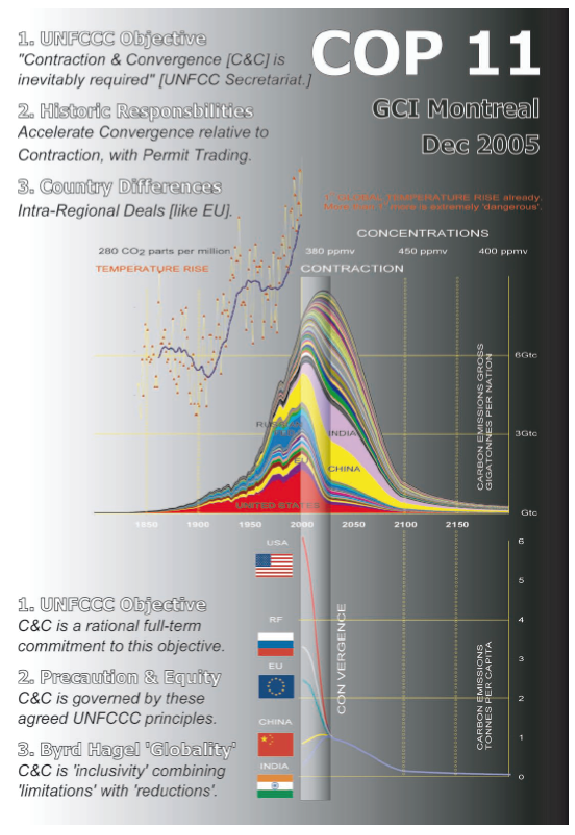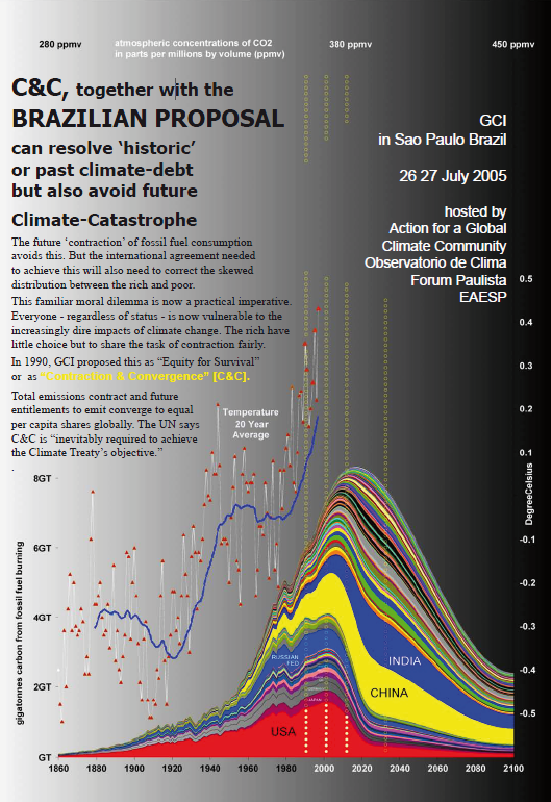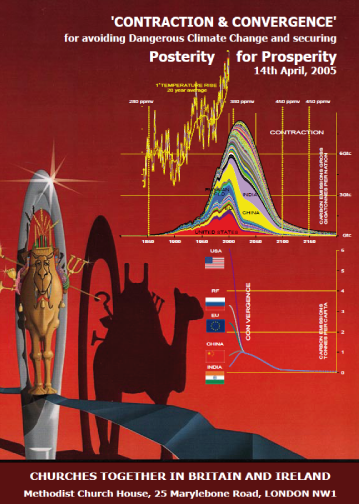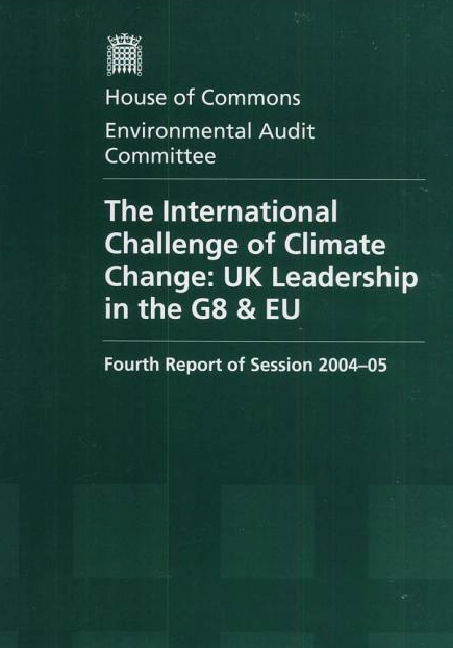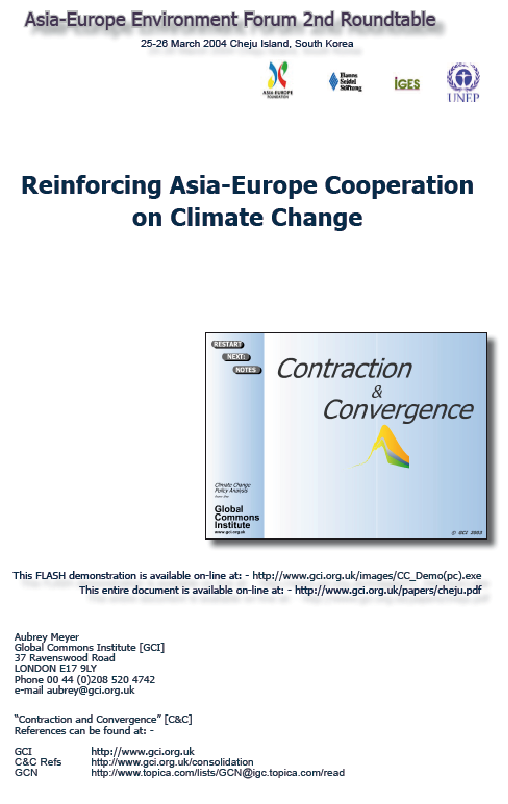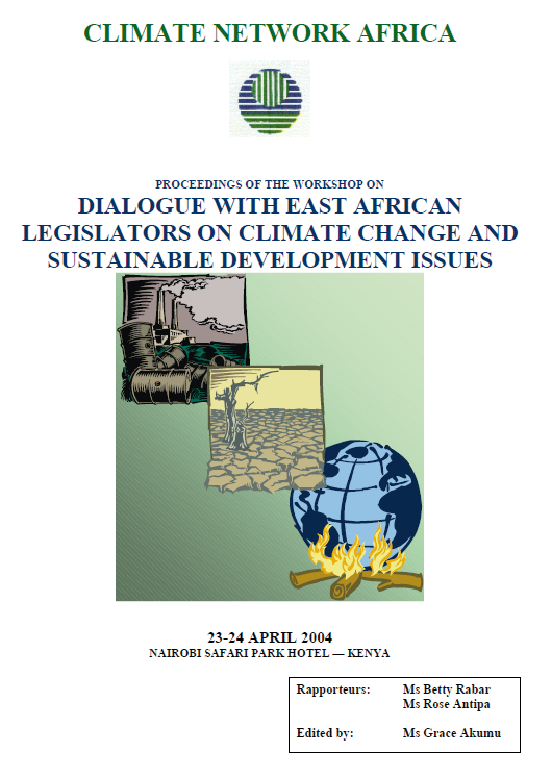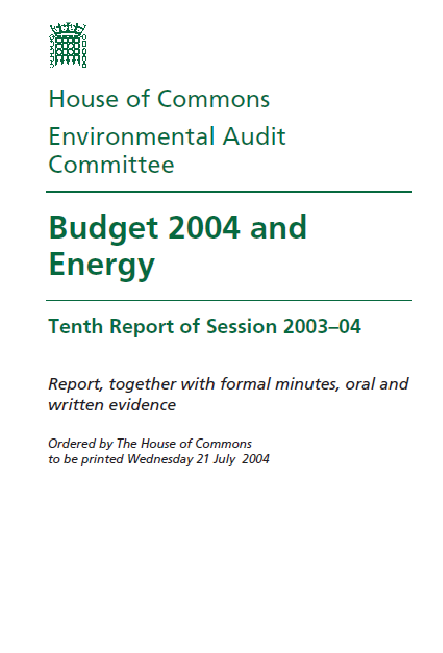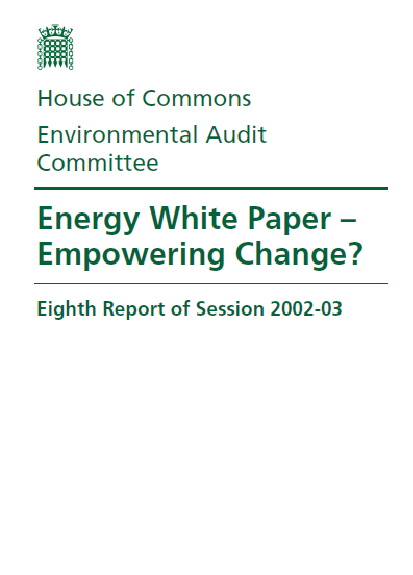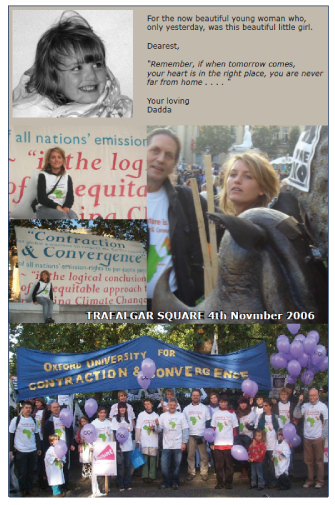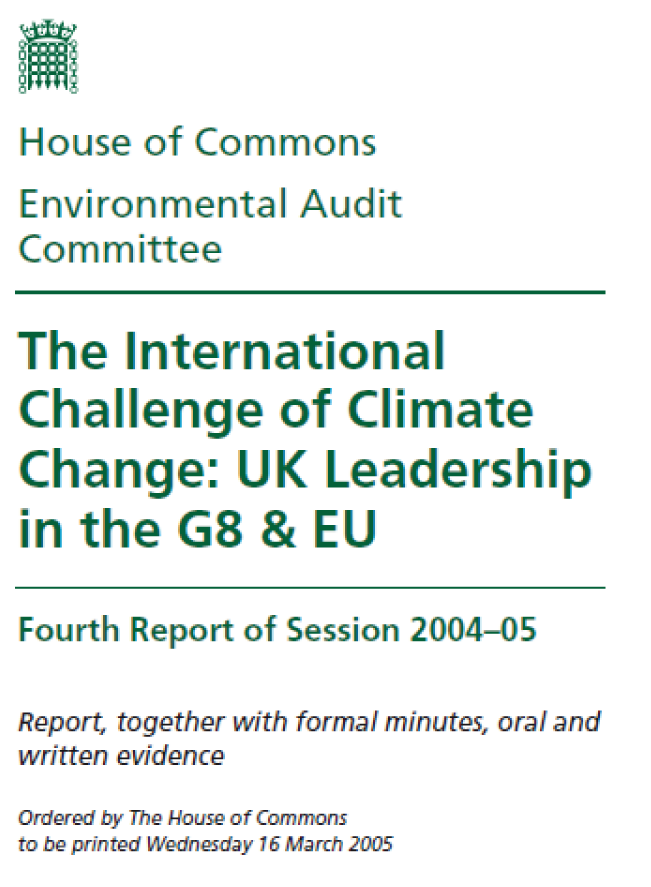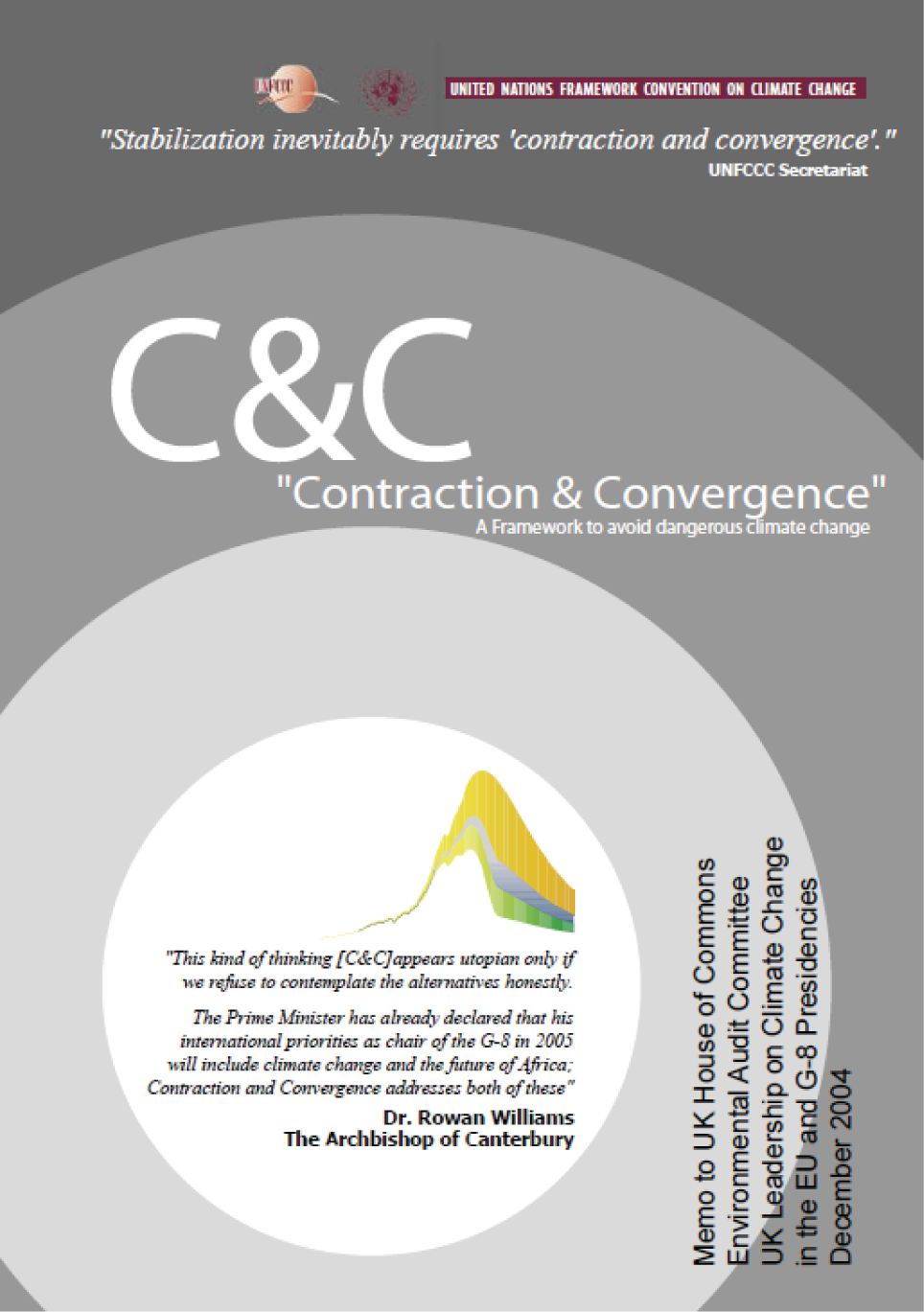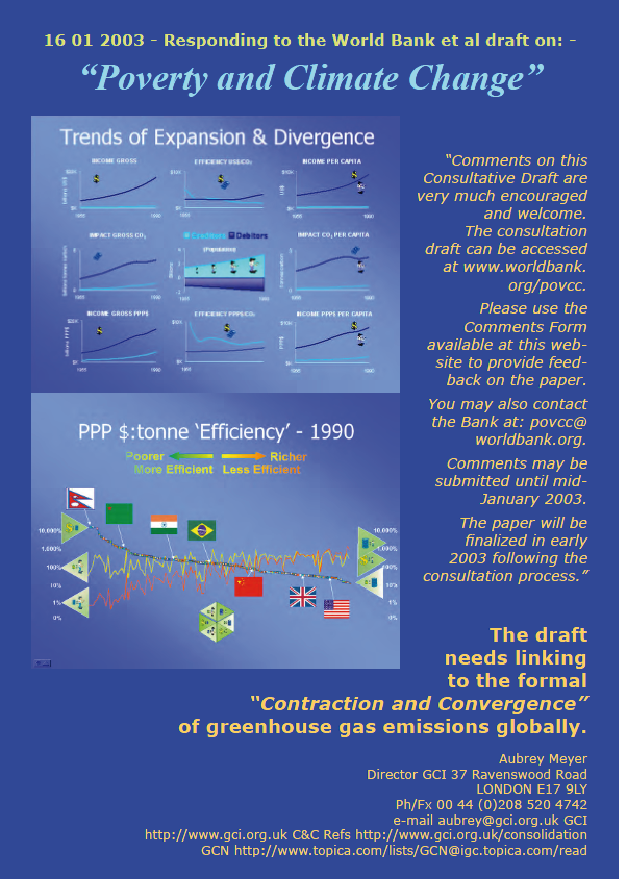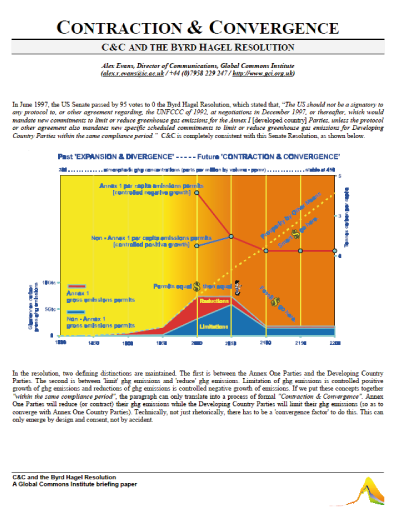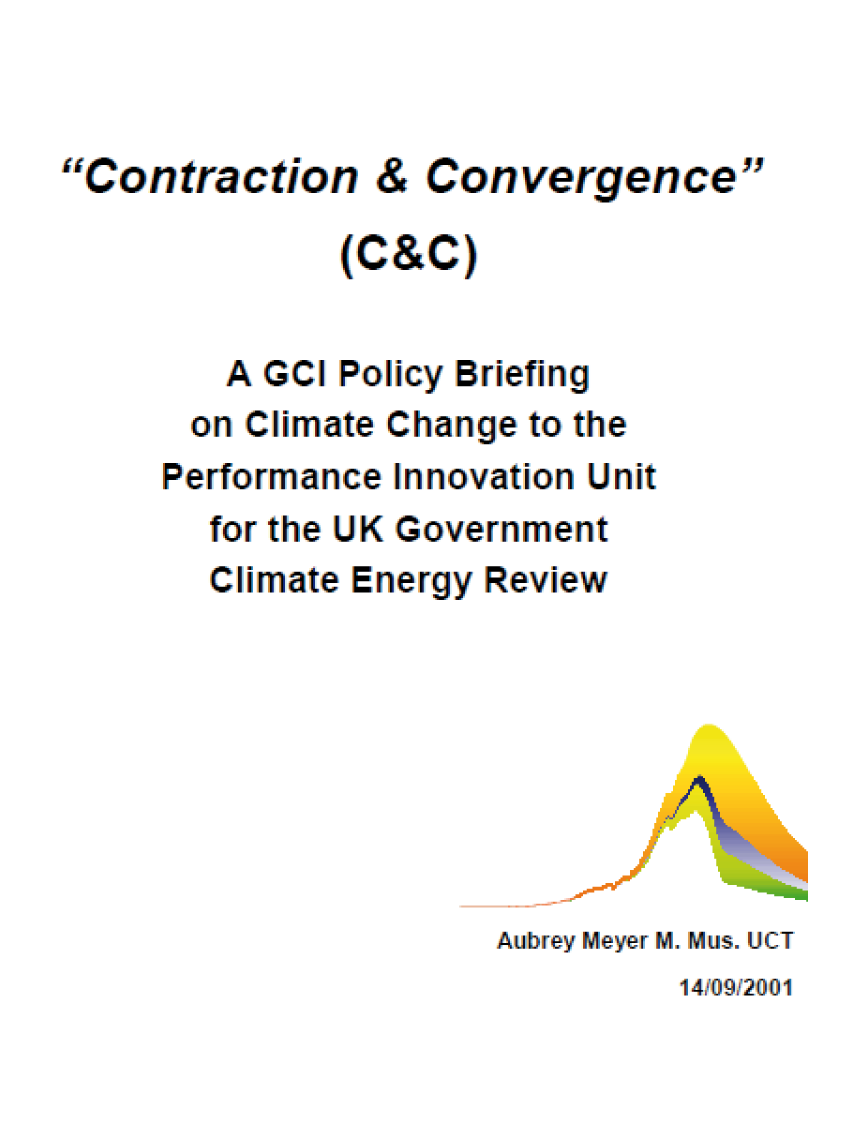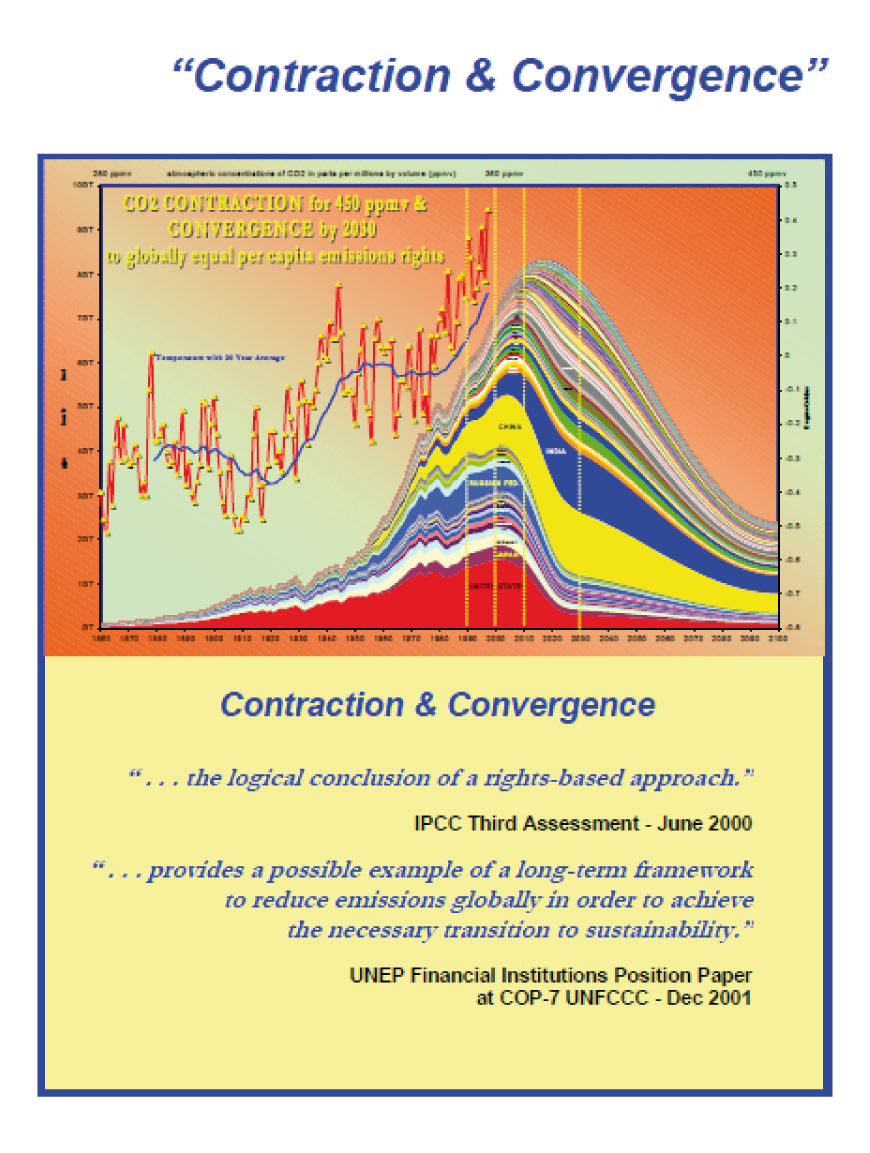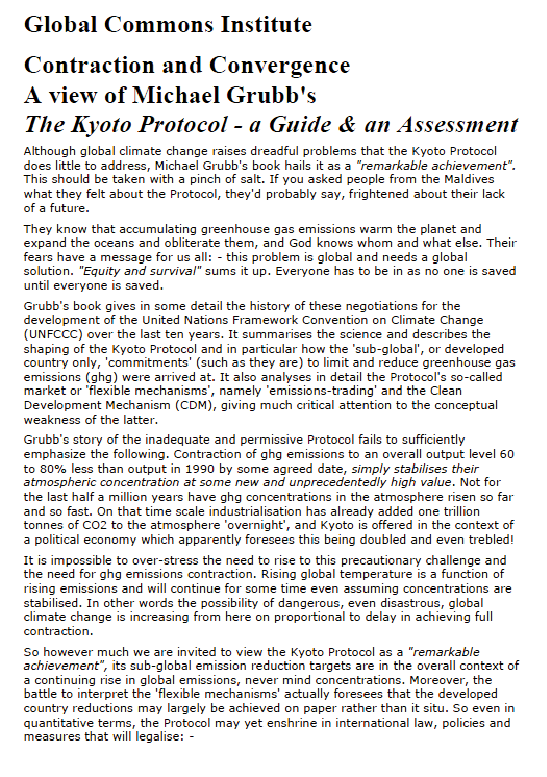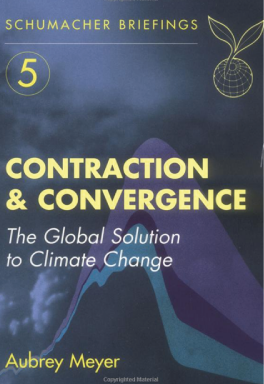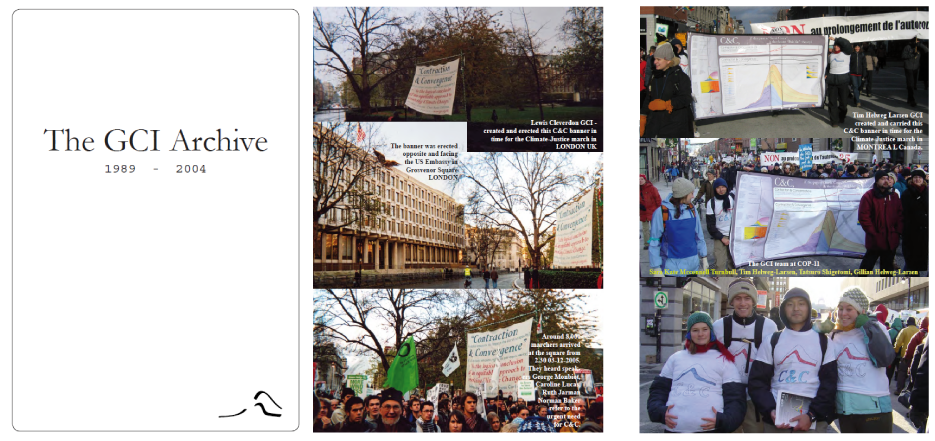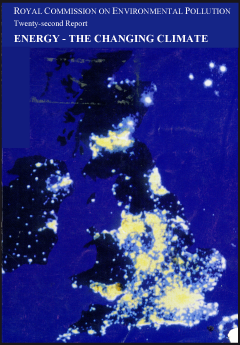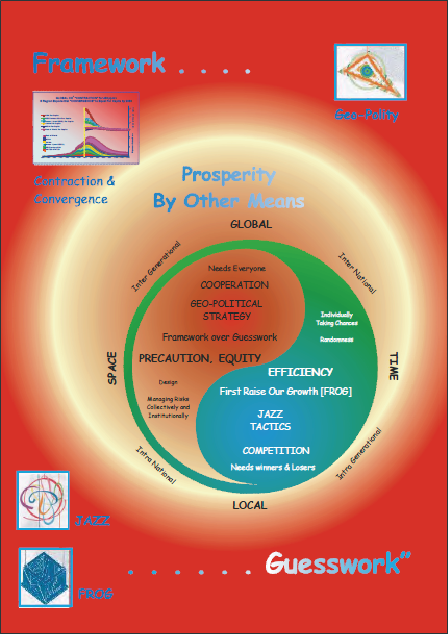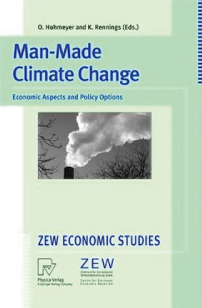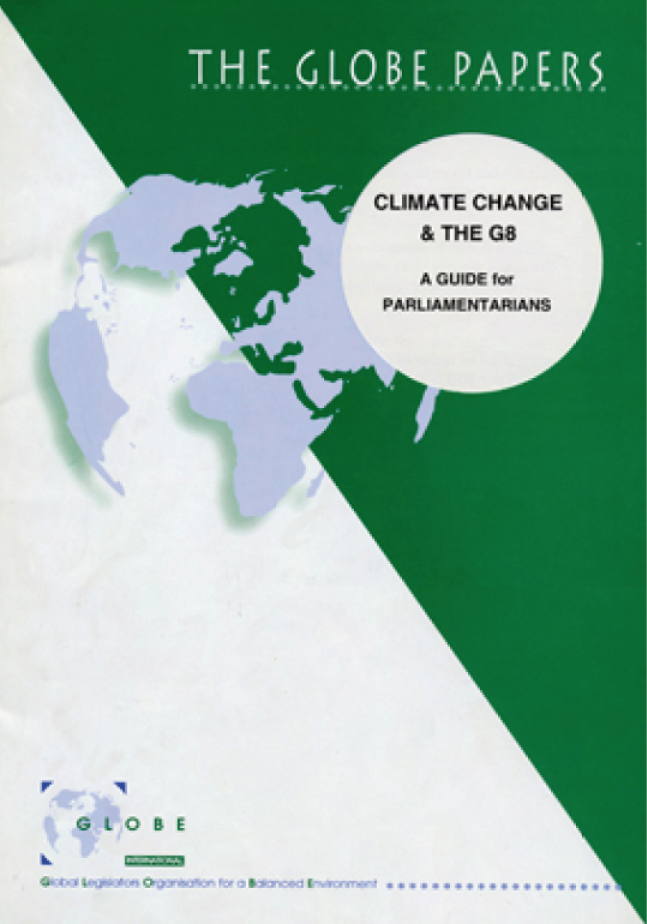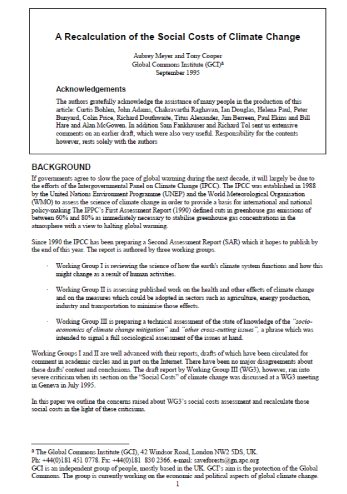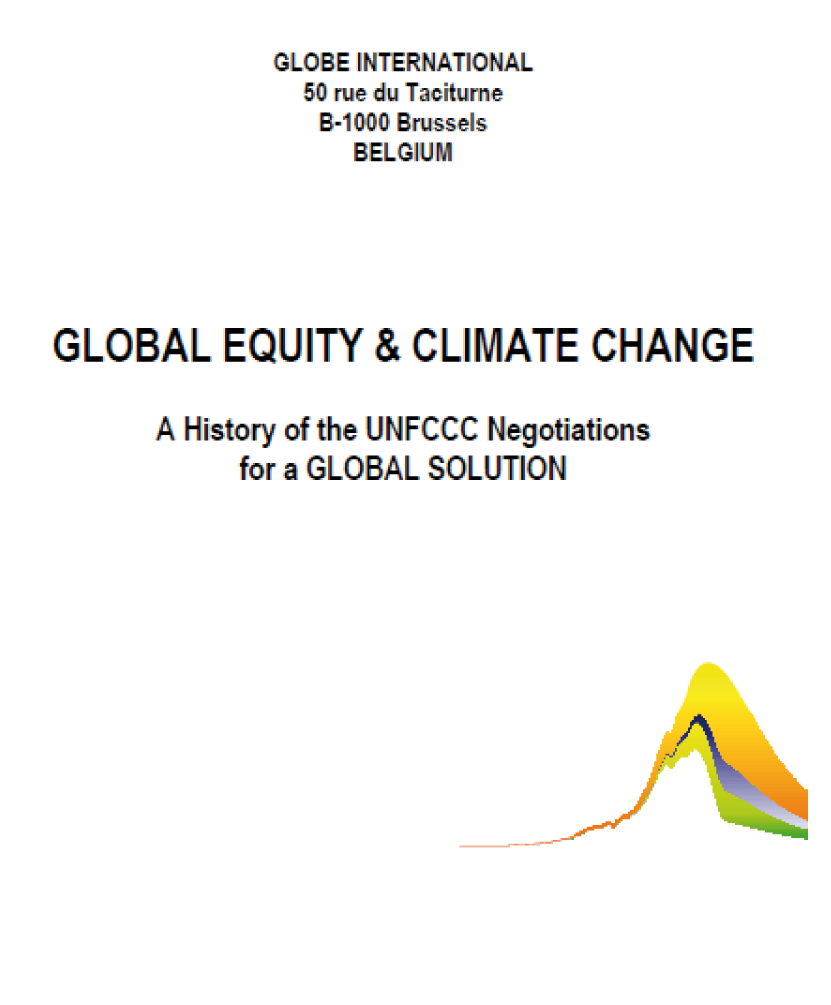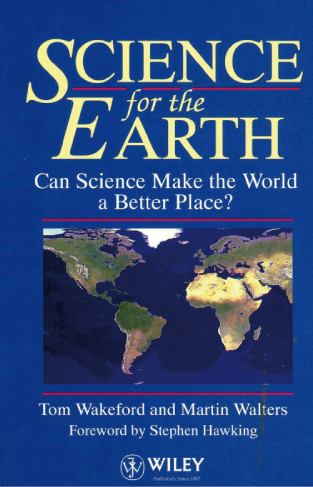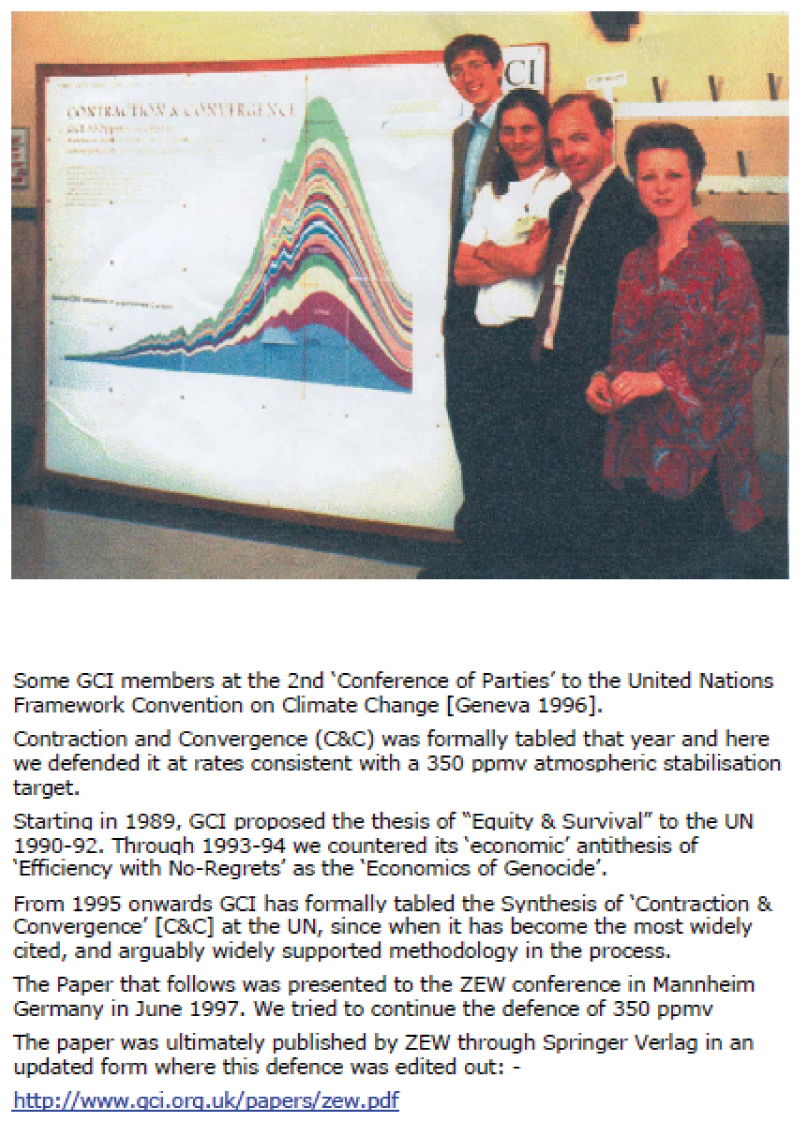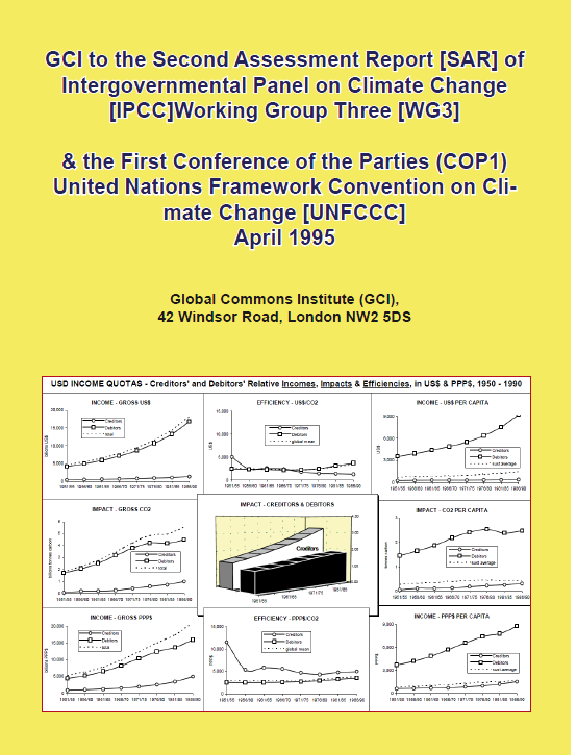This short paper takes a Chaldean algorithm and suggests the relationships between music, mathematics, meaning and international efforts to deal with climate change. Taking a cyclic view, the stringularity of a full-term C&C-event needs to complete within about the next five of these eight-earth-year-cycles, if dangerous rates of climate change are yet to be avoided. Imagine being kissed by Venus 25 times in the next 40 Years.
Pythagoras Renewed for Our Common Global Future
Aubrey Meyer & Jelle Hielkema
C&C models the international basis for negotiating a UNFCCC-compliant global climate treaty.
This requires safe and stable greenhouse gas concentration in the global atmosphere.[1] C&C was conceived by GCI in 1990.
[2] The formal calculating model of C&C was first introduced by GCI
to the UN Climate negotiations at COP-2 in June 1996.Since then the constant advocacy by GCI of this straightforward model has been effective and
C&C is now: -[1] the most widely cited and
[2] arguably the most widely supported basis for negotiating the future shares of
GHG emissions-entitlements that sum to achievement of the objective of the UNFCCC.The Contraction and Convergence campaign
A Short Summary
This dcoument, the support page, the awards page and the publications page
on the gci website, give some evidence supporting claims that C&C is now the most widely cited and
arguably the most widely supported model in the UN negotiations on climate change and the debates
these have given rise to.
The Endorsements Document
Pythagoras, Well-Tempered Tuning and UNFCCC-compliance with Contraction & Convergence [C&C]
The Well-Tempered Climate Accord a very widely cited and supported model.
To be In-Time, In-Tune and In-Harmony with Mother Earth and Nature
It examines how Optimism Bias has crept into the Assessment by the UK Government of its chosen 2016 4% Low Emissions Scenario, the scenario on which its Climate Act is based. It looks at how this bias now extends to the recent Government projections of the future deposition of CO2 in the oceans and the resulting increase in CO2 acidification of the oceans, and why they are unrealistically optimistic as well.
Report to the UN All-Party Parliamentary Climate Change Group [APPCCG]
A short BRIEF for the launch of the C&C Foundation at the Royal Society [17 01 2011] on
the Pythagorean origins of the C&C argument and meeting some of its evolution and
communication challenges from 1989 until the present time.
Uncertainty We must openly recognise uncertainty in all its forms and respond to it rationally and in
a precautionary manner. Knowledge of the science and its uncertainties must be distilled to support
the quantification of limits on temperature, concentrations and emissions as a first step in defining
a global mitigation strategy. GCI's Contraction and Convergence model is proposed in this light.
GCI - New sources of C&C advocacy [2009]. This booklet and the endorsements page on this website, give some evidence supporting claims that C&C is the most widely cited and arguably the most widely supported model in the UN negotiations on climate change and the debate these have given rise to.
"Humanity as a whole is already consuming more resources than the earth can in the longer term provide. Therefore consumption in the richer countries will have to be reduced to allow those in poorer countries
to attain a decent lifestyle. Consumption will inevitably grow in developing countries as they industrialise
and urbanise, even if they take on board the need for sustainable lifestyles. It will be up to wealthier communities, principally in developed countries, to moderate their lifestyles and adopt consciously
green practices. We already know that what one country considers acceptable would be considered
far from acceptable to another. How should the level be set? By whom? On what criteria?The concept of Contraction and Convergence (C&C) was conceived by the Global Commons Institute in the early 1990s. The principle is that the rich should consume progressively far less resources per capita than before, while the poor consume rather more than they did, so we converge towards a common fair share
for each, which the planet can sustain. We support this principle of C&C or global equity, but it must take account of the plain arithmetic fact that every additional person reduces the sustainable share of everyone else. We have therefore insisted on including a population base year at which the ultimate target figures,
notably for sustainable carbon emissions per person, should be calculated country by country.
Without it, countries with high population growth would consume ever more, at the expense
of those who had succeeded in restraining or reducing their numbers.We were delighted when Kofi Annan endorsed our view in his Key Recommendations as Chairman following
a conversation we had with him after a workshop we gave at the Global Humanitarian Forum in June 2009."
POPULATION MATTERS OPT
GCI brochure for a corporate audience, was published for COP-14 Poznan making the case for
the C&C Framework and the urgent need for this to be the basis of UNFCCC negotiations.
'Carbon Countdown' 2008
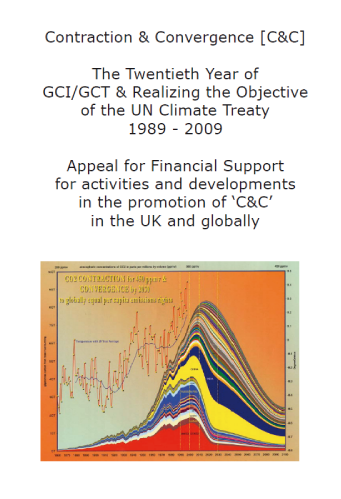
Contraction & Convergence [C&C]
The Twentieth Year of GCI/GCT & Realizing the Objective of the UN Climate Treaty 1989 - 2009
Appeal for Financial Support for activities and developments in the promotion of C&C in the UK
and globally.
The analysis showed clearly that Contraction and Convergence [C&C] is the preferable concept
with a view to tackling the problem of global greenhouse gas mitigation.This is not least because it conceptually avoids business as usual thinking, planning and forecasting.
If implemented, C&C has a higher chance to establish a global atmosphere of trust and to facilitate
the building of a more balanced global economic order based on sustainability, creativity, and equity.Nevertheless, I acknowledge that even if C&C has a higher potential to tackle the climate problem,
it may not be able to solve the climate problem as long as it is not supplemented with fundamental
reforms to address other grievances, foremost the human development crisis.Although GDRs has been designed with the intention to account for this deficiency, it fails to guarantee
for human development given its exclusive focus on income inequality and its fading out of social realities.
Since some goods and values are incommensurable, GDRs cannot simply be improved by choosing
another indicator for development or well-being.
Contraction & Convergence and Greenhouse Development Rights
A Critical Comparison between two Salient Climate Ethical Concepts
Katrin Simone Kraus 2009
The Global Commons Institute said that the origins of the advice from the Committee on Climate Change
could be traced back to advocacy by the Royal Commission on Environmental Pollution of contraction & convergence in their report Energy - the Changing Climate published in 2000.The Global Commons Institute promotes contraction and convergence as a means of resolving the impasse in international negotiations. Contraction and convergence is a framework for reducing global emissions of greenhouse gases that envisages global emissions peaking and then gradually falling (contraction). It achieves the reduction in emissions by limiting per capita emissions in such a way that they converge (convergence).
It entails large cuts in per capita emissions for developed countries while allowing developing countries to continue growing their economies before they have to make cuts to reach equal per capita emissions.
Lord Turner said that the advice of the Committee on Climate Change was, reasonably pragmatically close to Contraction and Convergence.
Carbon Budgets Volume 1
House of Commons: Environmental Audit Committee
Question: - Where did the UK budgets come from? Are they adequate to keep within the 2 degree limit?
- The UK budgets came from Contraction and Convergence via the Royal Commission on Environmental Pollution [RCEP] 2000 report Energy;The Changing Climate. The report recommended C&C but applied it at rates that are too slow to keep within the 2 degree limit.
- To keep within the 2 degrees Celsius temperature limit, the budgets need to be based on a global emissions contraction of 80% by 2050 and where the airborne fraction may still stay constant @ 50% giving a 450 ppmv outcome. But with sinks failing @ 0.5%/yr, the outcome only may still be 450ppmv.
- By not taking account of the new Coupled-Carbon-Cycle modelling in IPCC AR4 Chapter 10 [2007], the UK Climate Change Committee models and the assumptions used by the Committee on Climate Change are not valid in setting carbon budgets.
- There is unanimous agreement among the coupled climate carbon cycle models driven by emission scenarios run so far that future climate change would reduce the efficiency of the Earth system (land and ocean) to absorb anthropogenic CO2. There is evidence that the CO2 airborne fraction is increasing, so accelerating the rate of climate change.
- Until about 1800 the overall climate system was at equilibrium. The very sudden rise of the atmospheric concentration of CO2 and CH4 since then shows that the system is no longer in conditions of homeorhesis, it is going out of control.
- JokeWaller Hunter, Executive Secrearty of the UNFCCCCOP-9 in Milan in 2003 said, Achieving the goal of the United Nations Framework Convention on Climate Change inevitably requires contraction and convergence.
- The basis on which the UK Committee on Climate Change arrived at the UK share of the global effort to cut emissions was the RCEP and their advocacy of Contraction and Convergence.
- Convergence to equal per capita emissions entitlements globally for example by 2020, would reflect the C&C principle where, if contraction must be accelerated for reasons of urgency, convergence must be accelerated relative to that for reasons of equity.
- There appears to be an emerging consensus for Contraction and Convergence as the UNFCCC-compliant global framework for climate mitigation, as evidenced in the reference material attached to this memorandum.
- There is real danger of not doing enough soon enough to avoid dangerous rates of climate change.
- But with sinks failing @ 0.5%/yr, the outcome only may still be 450ppmv.
- In concert with others, the UK Government aim is to limit overal global temperature above pre-industrial to no more than two degrees Celsius. Not exceeding 450 ppmv CO2 in the atmosphere is considered a pre-requisite of keeping within that limit.
- Enforcing the right target will be no harder than enforcing the wrong target.
Carbon Budgets Volume 2 - the evidence
House of Commons: Environmental Audit Committee
ABSTRACT
Contraction and Convergence (C&C) is the policy framework proposed to the United Nations by the Global Commons Institute (GCI) since 1990. It was agreed in principle at COP-3 Kyoto 19973. Several European Government departments have issued statements supporting C&C since then. Nearly unanimously, the European Parliament passed a resolution in favour of C&C in 1998. Presently, we generate climate change faster than we organise to avoid it. The international diplomatic challenge is to reverse this. The purpose of C&C is to do this. It enables policies and measures to be negotiatied and organised at rates that demonstrably avoid dangerous global climate change. Taking the objective and principles of precaution and equity, as stated in the United Nations Framework Convention of Climate Change (UNFCCC), C&C proposes: -
- A full-term contraction budget for global emissions that stabilises the atmosphere at an agreed concentration of greenhouse gases (GHGs).
- The international sharing of this budget as entitlements resulting from a negotiated rate of convergence to equal shares per person globally by an agreed date within the full-term concentration agreement.
- The inter-regional, inter-national and intra-national tradability of these entitlements in an appropriate currency such as International Energy Backed Currency Units [EBCU]1.
- Improved understanding of the relationship between an emissions-free economy and concentrations, so rates of C&C evolve under periodic revision.
GHG emissions have so far been closely correlated with economic performance. To date the growth of economies and emissions has occurred mostly in the industrialised countries creating recently a global pattern of increasingly uneconomic expansion and divergence [E&D] and international insecurity. C&C answers E&D in a full-term constitutional, rather than a short-term random manner. It requires a progression from Guesswork to Framework. It enables the pre-distribution of future entitlements to emit GHGs that result from a rate of convergence deliberately accelerated relative to the overall agreed rate of contraction in order to resolve and go beyond inertial argument about historic debt. This synthesis of C&C can redress the dangerous trend imbalance. Built on global rights, resource conservation and sustainable systems, it is needed to guide the economy to a safe and equitable future for all. It builds on the gains and promise of the UN Convention and establishes an approach that is compelling enough to galvanise urgent international support and action with or without Kyoto. Many of the parties to the UN Framework Convention on Climate Change (UNFCCC) already support C&C. The Africa Group proposed it to the UNFCCC2 in August 1997. It was the basis of the emissions trade debate at COP-3 in Kyoto, December 1997.3
GCI Evidence to the House of Lords Enquiry
Dear Mr Rusbridger . . .
An unsuccessful attempt to get 'the Guardian' to deal justly with C&C
GCI Evidence to Enquiry by the UK House of Commons Environmental Audit Committee [EAC 2009]
"'Targets in the UK Climate-Act: Where did they come from; were the models on which it is based valid?"
showed they came from C&C and successfully challenged HMG on the 'odds' of their targets keeping
within '2 degrees' global temperature rise.
GCI Tracking climate-change's 'Economics of Genocide' 1993-2008,
ending with an interview at COP-9 Poznan with Nicholas Stern on his surprisingly extreme views.
Under C&C some developing countries, such as India and Indonesia, might only be permitted to increase emissions intensities for a very limited period, after which time they would be required to reduce them.
Other developing countries like Thailand and Venezuela, which have relatively high per capita emissions, would be required to reduce emissions immediately. However, it has been argued that that C&C could
provide an equitable framework for a genuine long-term solution to climate change, reducing political
risk and offering businesses and investors the sort of predictable framework they prefer.
Reaching an International Agreement on Climate Change
UK HoC Environmental Audit Committee
CONTENTS
How High will CO2 Go? Front Cover
Classic C&C Image Inside Front Cover
Contents 3
Royal Commission Advocates C&C 2000 4
UK Government Responses - Wait and C&C 5
C&C Animation Imagery of IPCC Sink failure 6 - 25
http://www.gci.org.uk/Animations/BENN_C&C_Animation.exe
http://www.gci.org.uk/Animations/BENN_C&C_Animation.hqx
C&C - The Proportionate Response 26 - 29
Scenarios for the Climate Assessment of Climate Risk 30 - 31
Carbon Countdown Campaign 32 - 43
C&C Definition Statement 44 - 47
C&C Chapter in Surviving Climate Change [PLUTO] 48 - 77
C&C Support 78 - 88
C&C Links to further information 89
Comments and Awards re C&C Campaign 90 - 92
C&C Framework for Preventing Dangerous Climate Change - Aubrey Meyer GCI
Meeting with Peter Betts, Director International Climate Change DEFRA
22nd August 2008
CONTENTS
How High will CO2 Go? 3
Kyoto 1997 - C&C at Political Climax 4
ADVICE: Support German C&C Initiative with India 5
UK Government Responses - Wait and C&C 6
Royal Commission Advocates C&C 2000 7
Contents 9
Surviving Climate Change 11-40
C&C Animation Imagery 41-63
http://www.gci.org.uk/Animations/BENN_C&C_Animation.exe
http://www.gci.org.uk/Animations/BENN_C&C_Animation.hqx
C&C Definition Statement 64-67
Comments and Awards re C&C Campaign 68-69
Carbon Countdown Campaign 71-101
C&C Article in Current Climate Action UNEP 88-91
C&C Support 92-101
C&C in IPCC and various references 102 to 111
Gore Gets on Message with C&C; Guardian 112
New Scientist Interview 113-117
Green Futures Interview 118-120
C&C Campaign makes Guardian 50 Heroes 121
British Medical Journal 122-123
Interview with David Adam 124-127
Cooperative Interview 128-129
Article for Sustain 130-132
The ACTUARY announces Carbon-Countdown 133
Imagine a charging Rhino Guardian 134
Syntax for Survival C&C Presentation 135-169
GCI Contribution to IPCC Second Assessment 170-217
GCI Contribution to IPCC Third Assessment 218-249
GCI Contribution to PIU Report 250-268
C&C in Springer Verlag 269-306
Recalculation of the Social Costs of Climate Change 307-324
Various Support 325-378
Links 379
BBCC&C - Will The Ravens Leave the Tower? 380
Thor and Baldrick 381
The Economics of Climate Change Chevening Rellows Programme
Aubrey Meyer GCI at Wolfson College Cambridge
Organised by Cambridge Programme for Industry
26th February 2008
Conclusion
The Rapporteur noted that it had been an intelligent discussion around the variants of Contraction and Convergence [Source: Contraction and Convergence (C&C) is the science-based, global climate policy framework proposed to the UN since 1990 by the Global Commons Institute]. Two secular states, India and the EU, appeared to be able to debate religious and ethical subjects such as Equity and Justice. Indian and European ideas had interpenetration over the last three hundred years. He reminded the Seminar that American insistence on a global deal involving China and India had not originally been a blocking tactic
and recalled widespread interest in convergence to equal per capita emissions in the months before the
Byrd-Hagel Resolution of the Senate ahead of the Kyoto Conference.
High-Level India-Europe Conference AGCC Potsdam, 27-29 May 2008 Potsdam
GCI Evidence to the UK Minister at DEFRA Hilary Benn in November 2007
"Will the Ravens Leave the Tower?" - concerning rates of C&C in the light of Coupled Carbon Cycle
modelling in IPCC AR4.
"Climate change is a pressing reality. From hurricane Katrina to melting polar ice, and from mass extinctions
to increased threats to food and water security, the link between corporate globalization and planetary blowback is becoming all too evident. Governments and business keep reassuring the public they are going
to fix the problem. An epochal change is called for in the way we all engage with the climate crisis.
Key to that change is Aubrey Meyer's proposed "Contraction and Convergence" framework for limiting
global carbon emissions, which he outlines in this book."
"Surviving Climate Change" Editors Mark Levene & David Cromwell
C&C Booklet for GTZ Conference Germany 2008
" ... to forestall further damages, deeper cuts in GHG emissions than as presently contained in the Kyoto Protocol are urgently required and these must be organised as universal equal entitlements as engraved in the principles of the Contraction and Convergence Framework."
KENYA GOVERNMENT - COP-11 Dec 2005
GCI Brochure for COP-12 Nairobi
GCI Occasional Paper for the Royal Society of Arts [RSA - 2006]
- Using C&C to organize doing enough soon enough to avoid dangerous climate change;
- CO2 Emissions and Concentrations A Bath-Tap Analogy;
- Expansion and Divergence Growth, Efficiency and No-Regrets;
- Contraction & Convergence - the whole truth and reconciliation;
- The Kyoto Protocol: half-truths and no reconciliation;
- C&C, Kyoto and the Byrd Hagel Resolution;
- How C&C conforms to the Byrd-Hagel Resolution;
- C&C and the Africa Group;
- C&C at COP-3 in Kyoto;
- Kyoto - Politics of Incompleteness:
- C&C - Intelligent Design; Doing Enough, Soon Enough
- Includes text of Colin Challen's C&C Private Members' Bill.
"The earlier section on A Consensus on Targets Plus Means? outlines some of the points on which consensus would be desirable and on which it might be reached, ranging from targets through a broad
policy framework to specific policy measures. In this section we list some of the areas in which measures might be agreed upon. We address two measures - Domestic Tradable Quotas (DTQs) and Contraction
and Convergence (C&C) in more detail, because they featured heavily in a number of submissions.
Both DTQs and C&C would be consistent with the acknowledgement that there is probably a maximum
safe atmospheric carbon dioxide concentration, and that staying below it necessitates a post-Kyoto concentrations-based international framework agreement for stabilising greenhouse gas concentrations.
The trading of emissions rights under this agreement (a cap-and-trade system) could be based on the C&C and DTQ (or other global and domestic carbon rationing) proposals.It is not our role to judge the merits of C&C. However, we recommend that the proposed climate policy group and the independent body (Recommendation 12) consider whether cross-party support should be given (a) to C&C as an approach to setting international emissions targets, and/or (b) to some form of national carbon-rationing system,
such as DTQs, alongside other means, as an instrument for achieving the targets that a C&C cap
would impose on the UK. Consideration of these issues may require further detailed research."
All Party Parliamentary Climate Change Group
Is a Cross-Party Consensus on Climate Change Possible Or Desirable?
Report of First Inquiry 2006 Prepared by Dr Helen Clayton, Prof Nick Pidgeon, Prof Mark Whitby
GCI Evidence [2006] to the All Party Parliamentary Group on Climate Change [APPGCC] enquiry
Is a cross-party consensus on climate change possible, or desirable?.
This resulted in the APPGCC Report itself which concluded, C&C, proposed by GCI, was favoured by several contributors to the inquiry. C&C is the subject of another Private Members Bill and associated Early Day Motion
and is supported by the RCEP, EAC, the UNFCCC and the German Advisory Council on Global Change among other bodies." WBGU Report
The Rt Hon Chris Huhne MP spoke in favour of C&C at the launch of the Report
In Brazil, where Aubrey and I attended, actually, the first public debate, on the whole issue, where the Brazilian historical proposals were put up and Aubrey argued his point. It was fascinating, that debate, and one of the key people, who had been one of the architects of the Brazilian proposals [Gylvan Luis Meira Filho], at the end said, "actually, it is Contraction and Convergence that makes better sense; the logic holds better."
Peter Luff AGCC Convenor
Panel Discussion 2006
The key messages in this document are: -
- The UNFCCC objective was agreed in 1992. It is a safe and stable greenhouse gas [GHG] concentration
in the global atmosphere. This is a quantitative limit, it is legally binding and must be set.- The agreed principles of precaution and equity in the UNFCCC are governed by this limit.
These are meaningless without a global calculus for combining them with the objective so we can
calculate how to come together at rates that are solving the problem faster than we are creating it.
Clean technology is not relevant without - and only relevant within - this calculus.- The historic responsibility of industrialised countries for raising GHG concentration in the atmosphere
is clear. To address this debt to the South, the C&C calculus demonstrates the future convergence
to equal tradable shares per capita globally and that this can and must be significantly accelerated
relative to the global contraction of emissions that stabilises GHG concentration in the atmosphere.
This is the realistic way to resolve the North/South arguments about blame for the past. Thus, in
the interdependent context of surviving climate change, the historic grip of poverty gives way to the
mutual benefit from the trading clean development for lucrative emissions equity and global survival.- To deal with the differing national circumstances that - subject to the accelerated convergence
under contraction - remain, intra-regional arrangements can be created, as already happens in the
European Union under the Kyoto Protocol, but - to avoid political chaos - away from the UNFCCC .- Not doing this is suicidal. Opposing this, as some do, is too. At the same time, proposing it in words
while not proposing it in the numbers, as some others do, is neither competent nor honest. Still
further, proposing to actually reverse existing per capita consumption differentials as yet others do,
is deluded. Unlike C&C, all of these tendencies are anti-consensus, confused and dangerous.- From the outset, the US persistently and correctly demanded globality - all countries are involved.
This was explained in the Byrd Hagel Resolution of the US Senate in 1997; commitment/entitlements
inclusively combine limitations with reductions under a global cap. C&C is the only proposition
in all the years of this process that directly answers and enables this demand. It prioritises
globality with carbon equity over growth, whilst under-writing the clean growth that is still possible.- Led by the Africa Group and supported by India and China, C&C was proposed and accepted in
Kyoto [See back cover]. C&C is now led again at COP-11 by - inter alia - the government of Kenya.
This document lays out the essential text of this proposition in thirteen languages. Some of the
clear support for C&C that has grown consistently since Kyoto, is at the end of this document.- Whatever atmospheric concentration target is set, C&C is inevitably required to achieve it.
These are the words of former Executive Secretary to the UNFCCC, the late and greatly valued,
Joke Waller Hunter. Then again, in the words of the Archbishop of Canterbury head of the Anglican
Communion, "C&C appears Utopian only if we refuse to contemplate the alternatives honestly."- It is evident time is against us. C&C can redress this and COP-11 can and should resolve to evaluate
C&C in SBSTA/SBI and establish it as soon as possible as the formal basis of future effort.
GCI Brochure for COP-11 Montreal
Contraction and Convergence (C&C)
Contract Global Carbon budget (2Gt-c/yr)
Converge all parties by 2050
Equity based (6 billion people/6Gt-C)
Comprehensive (all countries in UNFCCC)
Transparent process
Allows for emissions trading
Promotes Renewables
Lloyds Climate Change
Julian Salt
WORLD BANK ON C&C AND THE BRAZILIAN PROPOSAL
Two approaches that are receiving significant attention are Contraction and Convergence [C&C] and the Brazilian Proposal. Contraction and Convergence is a science-based global framework whereby total global emissions are reduced (i.e., contraction) to meet a specific agreed target, and the per capita emissions of industrialized and the developing countries converge over a suitably long time period, with the rate and magnitude of contraction and convergence being determined through the UNFCCC negotiating process.
It applies principles of precaution and equity; principles identified as important in the UNFCCC but not
defined. The proposal by Brazil, which is based on cumulative historical emissions and their impact on the increase in global mean surface temperature, aims at sharing equally the burden of mitigation
among all countries, industrialized and developing.GCI COMMENT ON C&C AND THE BRAZILIAN PROPOSAL
"A Unifying Strategy based on the merger of these two approaches, resolves the issue of historical
responsibilities with the future consumption patterns of fossil fuels and carbon pollution entitlements
that can be designed to avoid dangerous rates of global warming and climate change."
Under the chairmanship of former President Cardoso, an audience of around 100 people from the Brazilian Government gathered to listen to the debate between Miguez for the 'Brazilian Proposal' [BP - Author Luis Gylvan Meira Filho] and Aubrey Meyer for 'Contraction and Convergence' [C&C]. BP is essentially the precursor that led to the protest of the Kyoto Protocol while C&C is the strategic proposal for UNFCCC-compliance.
After an hour of presentations and debate, President Cardoso turned to BP author and veteran climate negotiator Luis Gylvan Meira Filho for a judgement: - after a long silence Luis said, "Aubrey is right."
GCI in Sao Paulo Brazil 26 27 July 2005
Hosted by Action for a Global Climate Community Observatorio de Clima Forum Paulista EAESP
CLIMATE CHANGE - ELECTION PLEDGE
Please will you consider supporting this pledge on the climate change policy-framework known as Contraction and Convergence [C&C] in your candidacy in the forthcoming UK election.I agree with the House of Commons All-Party Environmental Audit Committee [EAC] who have strongly urged the UK Government to provide leadership on climate change this year by committing itself to Contraction and Convergence [C&C] [1 & 2] as the framework within which future interna tional agreements to tackle climate change are negotiated. [3] I will advocate this C&C position during and beyond the forthcoming general election and urge the next government to seek support for this position during 2005 in advance of the next Conference of the Parties to the United Nations Framework Convention on Climate Change (UNFCCC). C&C is the stated party position of the Liberal Democrats [4], the Conservatives [5], the Greens [6] and is widely supported in the Westminster Parliament [7, 8 & 9] by Labour Party MPs too. It is also the position of the Church of England [10] the Africa Group of Nations [11] and is recognised as necessary by the UN. [12]. C&C is also supported by the Mayor of London and the GLA [13] by the Corporation of London [14] and widely internationally [15].
Posterity for Prosperity14th April, 2005
CHURCHES TOGETHER IN BRITAIN AND IRELAND
Methodist Church House, 25 Marylebone Road, LONDON NW1
Any framework which involves radical emission reductions would in practice resemble the Contraction and Convergence approach advocated by the Global Commons Institute. Indeed, in terms of domestic policy aims, the UK Government has already implicitly accepted this approach in adopting the 60% carbon reduction target for 2050; and it is therefore inconsistent not to adopt such an approach internationally. We do not see any credible alternative and none was suggested in evidence to our inquiry. We therefore recommend that the UK Government should formally adopt and promote Contraction and Convergence as the basis for future inter-national agreements to reduce emissions. We would urge the Government not to see its role during 2005 as being simply to broker international discussion. It should rather provide leadership by promoting specific objectives and targets. In that light we would make the following recommendations: (Paragraph 101) The UK Government should commit itself to Contraction and Convergence as the framework within which future inter-national agreements to tackle climate change are negotiated; and it should actively seek to engage support for this position during 2005 in advance of the next Conference of the Parties. Within the UNFCCC negotiating framework, the UK should press for a review of the adequacy of the commitments in the Convention, and focus its efforts on the need to agree more challenging absolute emission reduction targets within a post-2012 agreement.
The International Challenge of Climate Change
UK Leadership in the G8 & EU [contains extensive evidence, both written and spoken, from GCI to EAC].
UK Hoc Environmental Audit CommitteeA - C&C Evidence To House of Commons Environmental Audit Committee
B - C&C Evidence To House of Commons Environmental Audit Committee
C - C&C Evidence To House of Commons Environmental Audit Committee
GCI Contribution to Proceedings of the Asia-Europe Environment Forum Round Table
Jeju Republic of Korea 25-26 March 2004
GCI Contribution to Proceedings of the Asia-Europe Environment Forum Round Table
Jeju Republic of Korea 25-26 March 2004 republished by ASEF
GCI Evidence to BP [2004] A C&C 'world-view' [Powerpoint].
BP's statement followed later: - Contraction & Convergence helps greatly. It is inclusive and makes clear what needs to be achieved. Without such a shared model, there will not be the necessary relationships that create the new and exciting possibilities and the trust for shared action.
Chris Mottershead Distinguished Advisor Energy & Environment BP plc.
The workshop sought to galvanize urgent international support and action for the concept of Contraction and Convergence policy framework proposed to the United Nations Convention on Climate Change by the Global Commons Institute (GCI) since 1990. The African Group of Nations had proposed during the UNFCCC COP 3 that a globally agreed ceiling of GHG emissions can only be achieved by adopting the principle of per capita emissions rights that fully take into account the reality of population growth and the principle of differen-tiation. The way forward for East African legislators was envisaged as calling for the UNFCCC secretariat to study, evaluate and assess the concept of Contraction and Convergence, and at the same time set the stage for building a global community to support the concept as it added value to the Kyoto Protocol and also encompassed the major principles in the Climate Change Convention such as the Precautionary principle, Polluter Pay principle and the Equity principle.
Proceedings of the Workshop on Dialogue with East African
Legislators on Climate Change and Sustainable Developement Issues
Nairobi Safari Park - KENYA; 23-24 April 200
Q118 Mr Challen: You said in your January article that you were setting up a team to look at how the UK could mitigate its carbon emissions. I wonder if you could give us a progress report on that. In particular, whether you have had a chance to look at the cost to the UK of doing so, and whether indeed in its remit you might be asking it to look at the principle of contraction and convergence to see if that is a workable proposal?
Professor Sir David King: Can I take the second question first? Contraction and convergence has definite attractions, but there, again, we are talking on a global scale and we are talking about an alternative to the Kyoto process with carbon emission trading. Contraction and convergence is a permit system where you can exchange permits between countries. In essence it is a trading system but it does look at developing countries, so they can be brought on board by allowing them to build up their CO2 emissions while developed countries reduce, but they should peak at a certain level. I can see the attraction in the whole process, but I have to emphasise that the only game signed up to internationally is Kyoto, and until we have those absent from the signatories coming forward and saying "We would rather discuss contraction and convergence", I think we have to work within the Kyoto agreement. That is the process that we are set on.
Q119 Chairman: If Kyoto does not make progress because of the reluctance of some countries (and we know who they are and where they live) to participate, contraction and convergence must be a viable alternative.
Professor Sir David King: I think it is a very interesting alternative, but as I say I think the key thing is that if those countries that are not satisfied that Kyoto is the way forward come to us at the negotiating table, I am happy for us to negotiate on that, and I believe our government is, as long as it is not seen to be a delaying tactic, because I think this is a matter of some urgency.
UK HoC Environmental Audit Committee 10th Report
Budget 2004 and Energy
However, the RCEP pointed out that the 60% target was in the context of an international agreement to a 'contraction and convergence' (C&C) framework, and it recommended the adoption of such an approach, combined with international trading in emission permits, as offering the best long-term prospect of securing equity, economy and international consensus. The Energy White Paper says nothing about the latter, and the
Government response to the RCEP recommendation is non-committal, citing C&C as only one of a number of possible approaches which could be adopted. While we understand the need for some flexibility in inter-national negotiations, we are aware of the difficulties of achieving a consensus. We believe that, just as the UK is setting a precedent in terms of adopting a long-term target, it could also exert greater influence over other nations by setting out and promoting more clearly what approach it favours in terms of an international framework for reducing carbon emissions.
UK HoC Environmental Audit Committee 8th Report
Energy White Paper - Empowering Change?
The GCI Archive 2000 - 2008
Year by year collection of articles, press reports, statements
"Any framework which involves radical emission reductions would in practice resemble the Contraction and Convergence approach advocated by GCI. Indeed, in terms of domestic policy aims, the UK Government has already implicitly accepted this approach in adopting the 60% carbon reduction target for 2050; and it is therefore inconsistent not to adopt such an approach internationally. We do not see any credible alternative and none was suggested in evidence to our inquiry. We therefore recommend that the UK Government should formally adopt and promote Contraction and Convergence as the basis for future international agreements to reduce emissions."
GCI Evidence to the EAC C&C Enquiry the EAC Report on C&C [the UK House of Commons Environmental Audit Committee enquiry into C&C - 2004] resulted in this statement.
GCI Memo to UK House of Commons Environmental Audit Committee -
UK Leadership on Climate Change in the EU and G-8 Presidencies [December 2004]
Responding to World Bank Draft
On Poverty and Climate Change
Introduction to C&C
The consequences of global climate change are ultimately incalculable. However, economic losses from natural disasters (80% weather related) are now growing at 12% a year. That is four times the rate of growth in the global economy. Assuming the growth rate of 3% in the global economy continues, these losses will exceed the total value of all human production within two generations on current trends. (chart page 6). The research compiled by IPCC also indicates that the future risks are grave and will compound with the underlying trends in unsustainable development. That is why in December 1999, the heads of the US National Ocean Atmosphere Administration and the UK Meteorological Office stated, "We are in a critical situation and must act soon." In January 2000, 1,000 Corporate CEOs at the Davos World Economic Forum said: - "Averting climate change is the greatest challenge facing the world, why has more not been done to avert its devastating trends?" In March 2000, the UK Prime Minister said; - "The process is accelerating. For some parts of the world, particularly the poorer parts, the effects will be catastrophic." To avert these devastating trends and bring the process of climate change under control as soon as possible, GCI proposes an international framework for controlling the greenhouse gas (ghg) emissions whilst positively stimulating the growth of renewable energy technologies and their international markets. This framework is 'Contraction and Convergence' (C&C) and is outlined on page 4. C&C recognises that to avert these trends, climate-efficient commerce must be politically guided, rather than solely reliant on the market, if we are to achieve the objective of the United Nations Framework Convention on Climate Change (UNFCCC) and thus enable future economic and social development to be sustainable. Establishing the C&C framework is at the political and constitutional heart of the UNFCCC process so as to progress: -
- Choice and opportunity
- The reduction of regional inequity across the world
- An orderly transition from carbon to renewable energy technologies
- The reversal of the exponential rise in catastrophic losses
All these are fundamental to long-term prosperity and security. By globally integrating precaution, equity and efficiency, C&C coordinates control to reduce risk exposure at source. It thus defines the political commitment necessary to avoiding dangerous climate change while promoting prosperity by other non-carbon energy based means. The case for C&C is compelling and as governments, industry and civil society conjoin in its enabling simplicity, C&C will become the standard by which progress at the UNFCCC is measured. As
Appendices One and Two of this document suggest, C&C has wider international support than any other global proposal. Also in the context of creating global emissions permits as tradable property rights, C&C is described in the Policy Section - Working Group Three - of the IPCC Third Assessment Report as, "taking the rights-based approach to its logical conclusion."
GCI Documentation for Wilton Park Conference 2002
A 70th Birthday Tribute to Dr Mayer Hillman and his diverse and remarkable legacy.
All the authors of the essays wrote tributes as though for his 90th birthday and the volume was presented to him on his 70th birthday in 2001.
Ahead of Time with the full volume here
GCI Briefing on C&C and the Byrd Hagel Resolution
In June 1997, the US Senate passed by 95 votes to 0 the Byrd Hagel Resolution, which stated that, "The US should not be a signatory to any protocol to, or other agreement regarding, the UNFCCC of 1992, at negotiations in December 1997, or thereafter, which would mandate new commitments to limit or reduce greenhouse gas emissions for the Annex I [developed country] Parties, unless the protocol or other agreement also mandates new specific scheduled commitments to limit or reduce greenhouse gas emissions for Developing Country Parties within the same compliance period." C&C is completely consistent with this Senate Resolution, as shown in this briefing.
GCI Memo to PIU Enquiry 2001 [Cabinet Office]
1. This paper by the Global Commons Institute (GCI) is a response to the UK Government's Performance Innovation Unit (PIU) review of energy policy and avoiding dangerous global climate change announced in June 2001.
2. Announcing the review PIU observed, "The project's outputs will be a key input to the UK Government's future policy on security and diversity of energy supply and on climate change including its response to the Royal Commission on Environmental Pollution (RCEP) report on 'Energy the Changing Climate'.
3. The approach GCI puts forward here is to re-state our advocacy of 'Contraction and Convergence' (C&C) as the most logical way to organise the international effort to avoid dangerous climate change.
The project Stated: - The outputs will be a key input to the UK Government's future policy on security and diversity of energy supply and on climate change including its response to the Royal Commission on Environmental Pollution (RCEP) report on 'Energy - the Changing Climate'.
Its Report finally stated: -"A 'leading approach' implies measures to prepare for a world of long-term emissions limits agreed bewteen all countries possibly based on 'contraction and convergence'.
Compilation of GCI C&C papers and appreciation statements [2002]
As Grubb recognises, once negotiated, the tradable ghg allocations that result from "Contraction and Convergence" represent a financial asset. Consequently, the rate of convergence negotiated under an agreed contraction profile will determine a distribution of these. Here again, no GCI or GLOBE preference has been asserted with regard the rate of convergence. We simply assume that if the solution to achieving an international contraction and convergence is formally based on "Contraction and Convergence", the rate of convergence will reflect the compromise between the Industrialising Countries who will for obvious reasons want it to be rapid and the Industrialised Countries who will not. Insisting on his independence, he declined to alter the Chatham House preference for 'long-term' convergence saying in separate letter to GCI that rapid convergence would be laughed out of the USA. In response to this I requested permission to make known GCI's views about this issue at the international conference organised by Chatham House around the launch of his book. This request was refused. Had it not, I would have said what follows. It is central to the impartial advocacy of "Contraction and Convergence". The role of independent experts is to show all the negotiators what all their collective options are especially if this means exposing the gap between what is logically correct and what is perceived to be politically correct. The task is to uphold logic in the face of powerful interests.
GCI has made this effort for better or worse for the last ten years. The results have been bruising but never been less than interesting. Where Grubb links GCI to the "most unpleasant controversy", he actually misses the point. The UK economist David Pearce, had sought unsuccessfully to maintain that it was "scientifically correct" to equate 15 dead Chinamen to one dead Englishman, saying it was merely "politically correct" not to. GCI took the view that it while it was neither scientifically or politically correct to do this, it just wasn't logical. Now likewise Grubb's view of convergence is political but also illogical when he says that "Contraction and Convergence" must be sold in the configuration least likely to offend the USA. This is not to deny Chatham House the right to have this political sensitivity most on their minds. But it is not reasonable to falsely create an impression that GCI and GLOBE are somehow linked to their political views. Politically it will obviously have precisely the opposite effect in China. Indeed, Chinese officials have privately supported "Contraction and Convergence" recognising that short-term convergence is also a case that can be logically argued within the total structure.
Global Commons Institute Contraction and Convergence
A view of Michael Grubb's The Kyoto Protocol - a Guide & an Assessment
"Contraction and Convergence is a mechanism for getting global agreement on the reduction of greenhouse gas emissions. Like all the best ideas, it is easy to grasp. It is founded on two fundamental principles that cannot be questioned except by very devious linguistic distortions: first, that the global emission of greenhouse gases must be progressively reduced; secondly, that global governance must be based on justice and fairness. Under the second principle, the emission of greenhouse gases must be based on an equal per capita allowance. It is this second principle that makes it particularly relevant to recent clashes between Civil Society and the world financial organisations - the World Bank, the International Monetary Fund and the World Trade Organisation. In dealing with the global economy the IMF, rightly, sees the need for 'structural adjustments'. By this, it means adjustments to the economy and practices of nations that will lead to continuing, rather than short term, benefit. But the structural adjustments being imposed by the IMF on poor nations are primarily designed to strengthen the global economy in the hope that wealth will trickle down from the wealthy to the poor. Seen from the perspective of poor countries, 'structural adjustments' need to be made to the practices of the industrial nations since it is their consumption and emissions that are destroying the natural world, and it is their economic system that has led to such massive inequality. Contraction and Convergence is such an adjustment. Contraction and Convergence is a mechanism by which money would flow from rich to poor nations as of right, not as aid. It would introduce a mechanism by which the world economy would move in the direction of greater equality. It is based on a simple principle of justice that any schoolchild can understand, and therefore should be difficult for negotiators to pervert."
From James Bruges Foreword to
"Contraction & Convergence: The Global Solution to Climate Change" - Aubrey Meyer
Some Reviews
The GCI Archive 1989 2004
Year by year collection of articles, press reports, statements
Chapter 4 of the Royal Commission on Environmental Pollution Report [RCEP 2000],
"Energy the Changing Climate" resulted in their 'Key Recommendation': -
"The government should press for a future global climate agreement based on the contraction and convergence approach, combined with international trading in emission permits. Together, these offer the best long-term prospect of securing equity, economy and international consensus."
GCI Evidence to the IPCC Third Assessment [TAR 2000] on the issue of Guesswork versus Framework in UNFCCC negotiations. The result was, "A formulation that carries this the equal rights based insight to its logical conclusion is that of 'contraction and convergence' (GCI, 1999).
The material in this booklet includes: -(1) An overview of the 'Frog, Jazz, Geo-Polity' storylines of the future [World Business Council for Sustainable Development],
(2) A summary of future climate risk and the "Contraction & Convergence" (C&C) framework-over-guesswork response and
(3) An extended list of pro-"Contraction and Convergence" references known to GCI at the present time.Uniting Nations in a Framework Consensus of C&C
GCI October 2000
"The Kyoto Protocol, completed in the early hours of December 11th 1997, at present is no more than a potential breakthrough in the development of effective global policy for the control of atmospheric concentrations of greenhouse gases and the mitigation of human-induced global climate changes. The core issue of the negotiations has been deferred until COP4 in November 1998. The industrial countries have negotiated a compromise that subject to ratification will legally bind them to commitments beyond those in the UNFCCC. But, the ratification of the Protocol by the US still remains contingent on achieving the 'meaningful participation' of 'key' developing countries in the abatement regime and the multilateral acceptance of international emissions trading. This is a struggle to define property rights. These key developing countries include India and China and they have made it clear that their acceptance of trading is contingent on the achievement of 'equitable allocations' of emissions entitlements based on achieving equal per capita entitlements globally.COP issued instructions to the technical bodies attached to the UNFCCC to 'define the relevant principles, modalities, rules and guidelines for emissions trading' in time for COP4 in November 1998 in Buenos Aires. GCI argues that "Contraction and Convergence" is the approach that can break through this deadlock and welcomes the fact that major parties and interest groups in this dispute have already acknowledged that they take this approach seriously and that it has growing support throughout the world. As a leading economics commentator Peter Jay has noted, "unless there is some recognition that eventually no one group of human being can expect to have an internationally recognised right to consume more of the world's limited capacity to absorb greenhouse gas emissions than any other group, it is hard to see how a globally enforceable policy can be built by consent." And in the words of the President of GLOBE International, "Contraction and Convergence is not simply the right way to solve the problem, it is the only way to solve the problem."
The Kyoto Protocol and the Emergence of 'Contraction and Convergenca'
as a framework for an international political solution to greenhouse gas emissions abatement.
A Meyer 1997 -Springer Verlag
GLOBE C&C Briefing for Parliamentarians.
On Sunday the 17th of May 1998, the leaders of the developed world and Russia will sit down in Birmingham at the World Economic Summit to discuss climate change."Contraction and Convergence" is the only practical and convincing way forward for the world. It is vital that the G8 leaders recognize this and commit themselves to negotiating ahead of COP4 the global solution for what everyone accepts is the global problem. Such negotiation can only be based on the principle of equity and the establishment of the robust and flexible model contained in these pages.
Reassessing Cost Benefit Results
In IPCC SAR, the Global Cost Benerfit Analysis of Climate Change was deeply flawed. Its assumptions about monetary valuation of the assets at risk from 'climate-damages', not least the now infamous 'unequal valuation of life' foundered and were rejected. The analysisis in this GCI document played a significant role in that outcome.
GCI - Brief History of the Negotiations at the UNFCCC to 1998.
Economics - Still a Dismal Science?
GCI C&C Paper for ZEW 1996 Conference Mannheim after COP-2, UNFCCC Bonn June 1996.
Some GCI members at the 2nd 'Conference of Parties' to the United Nations Framework Convention on Climate Change [Geneva 1996]. Contraction and Convergence (C&C) was formally tabled that year and here we defended it at rates consistent with a 350 ppmv atmospheric stabilisation target. Starting in 1989, GCI proposed the thesis of 'Equity & Survival' to the UN 1990-92. Through 1993-94 we countered its 'economic' antithesis of 'Efficiency with No-Regrets' as the 'Economics of Genocide'.From 1995 onwards GCI has formally tabled the Synthesis of 'Contraction & Convergence' [C&C] at the UN, since when it has become the most widely cited, and arguably widely supported methodology in the process. The Paper here was presented to the ZEW conference in Mannheim Germany in June 1997. We tried to continue the defence of 350 ppmv. When finally published by ZEW through Springer Verlag in an updated form, [see here] this 350 defence was edited out.
GCI Evidence to the IPCC Second Assessment [SAR 1995] on 'The Economics of Genocide' in SAR's Global Cost/ Benefit Analysis. [Supplementary here: - MON_ECO] The result was SAR 'Policy Makers Summary': -
"Literature on the subject in this section is controversial and mainly based on research done on developed countries, often extrapolated to developing countries. There is no consensus about how to value statistical lives or how to aggregate statistical lives across countries. Monetary valuation should not obscure the human consequences of anthropogenic climate change damages, because the value of life has meaning beyond monetary value."
THE industrialised countries receive an energy subsidy from the South worth $3.1 trillion annually at current value. This is the political issue at the UN climate negotiations under way again in New York. This figure reflects the fact that 93% of global Gross Domestic Product is generated with fossil fuels at levels above that required to preserve climate stability. This is done by 36% of the world's population. The other 64% generate 7% of global fossil GDP at or below the sustainable level. The extent of their unused 'fossil GDP' entitlement was $3.1 trillion for 1990. The current conditional offer through the World Bank from the subsidised North is at best 0.00006% of this amount. This is a confidence-busting measure at a time of deepening crisis.
CLIMATE CHANGE & THE PRECAUTIONARY PRINCIPLE
GCI at the UN March 1993
GCI - The Noose of Equity Survival [for 'Medact' 1992]
The graphic shows a model of the bio-sphere as a 'closed-system'. All feedbacks in the system are self-intemalizing and result in an overall condition of benign evolutionary self-regulation. Our bio-sphere loop is looped upon itself with three cross-over points. These give rise to the appearance of three sub-loops or 'petals' all sharing a common space at the centre of the 'knot'. The common space at the centre especially represents the geo-sphere/bio-sphere upon which all human activities depend. This is only initially unaffected by human activities. The petals we shall assign to represent population, production and pollution and the growth of these.
GCI - Climate Change and the Paradox of Growth [1991]Â
.
.
.
.
.
.
.
Carbon budgeting consistent with 'Paris Agreement' is now increasingly widely supported.
All Country CREDIT DEBIT introduction

